#first appearance of captain marvel since golden age of comics
Explore tagged Tumblr posts
Text

#Shazam!#dc comics#first issue#1973#captain marvel#billy batson#the world’s mightiest mortal#first appearance of captain marvel since golden age of comics
48 notes
·
View notes
Text
[RERUN] Crisis on Infinite Earths, Issue 10: “Death at the Dawn of Time” (Monitos, the Hand of Oblivion)

[All images are owned by DC Comics, please don’t sue me]
PREVIOUSLY ON…
A being known as the Anti-Monitor has destroyed all but 5 of the universes in existence) with a single survivor on Earth-6 (Lady Quark) along for the ride). Those 5 (1 (Silver Age), 2 (Golden Age), 4 (acquired from Charleton), S (acquired from Fawcett after being sued into oblivion), and X (acquired from Quality)) are being held in limbo (and are merging into a single reality) away from the Anti-Monitor thanks to a being known as Lyla, assisted by a being known as Pariah and the sole survivor of Earth-3 (Alexander Luthor, who is made of matter and anti-matter).

Unfortunately, the process was unstable, meaning that time has merged (meaning mammoths and futuristic aliens are among modern skyscrapers) in the areas where the Earths are merged (which are called “Warp Zones”)
The Anti-Monitor has been quiet since his third attempt at destroying the multiverse failed (thanks to the sacrifices of Supergirl and Earth-1’s Flash)
Meanwhile, Brainiac and Earth-1’s Lex Luthor have drafted the villains of all 5 Earths and have taken over Earths 4, S, and X. The combined heroes of the 5 Earths have staged an assault to free the Earths while Brainiac and Luthor sit back on Brainiac’s ship and prepare to pick up the pieces while the heroes and villains kill each other.
However, Psimon didn’t join the battle, but stayed back and listened. Having heard the Master Plan, he thought it was a good one, only he should be the one in charge, so he destroyed Brainiac and prepares to do the same to Luthor!
Now, on with our story! If you would like to read this issue, it (along with the rest of the series) has been collected in graphic novel form and is available (or can be ordered) at your favorite comic shop, bookstore, or online retailer…or on Read Comic Online.
As Psimon uses his psychic powers to fry Luthor’s insides…

He is shot in his brain bubble (I’m surprised no one thought of this before) from behind by Brainiac, (wait, what?!) killing him instantly (psee ya later, Psimon!) It turns out Brainiac’s consciousness is linked to the ship and knew Psimon was there (and he didn’t do anything about it before then?) and constructed a new body for him after his first was destroyed (if he dealt with Psimon before then he wouldn’t have had to waste the resources) Luthor slaps himself on the back (quick recovery after nearly being Scannered [NSFW WARNING]) and gets on with the plan.
Speaking of the plan…

Casualties mount as the Doom Patrol’s Negative Woman destroys Chemo

…and the Teen Titans’ Kole turns Black Adam to crystal (who world have been shattered by the Doom Patrol’s Robotman if Kole’s teammate Dove hadn’t stepped in)

Earth-1′s Atom frees Billy Batson so he can speak his magic word to become Captain Marvel and begin to wipe the floor with those who held him captive (and why didn’t they kill him exactly?) And so on…
Until…

An energy surge unlike any other seen appears on every scanner across five Earths…
Then…

I had no idea the Spectre could do that!
Anyway, the Spectre tells the population of 5 Earths (kinda hard to ignore a giant white and green head over the entire skyline) that the Anti-Monitor has retreated to the dawn of time, where he intends on being the hand that Krona (remember him? All the way back in issue 7) saw, thus destroying all the other universes (how is this Plan D? I would think this would be Plan A) The Heroes decide to travel to the Dawn of Time to try to stop the Anti-Monitor, while the villains (despite protests) head to ancient Oa to stop Krona.
The assembled heroes and villains gather to make their respective time-jumps.

As they prepare, we see a touching good-bye between Kal-L and his wife, Earth-2′s Lois Lane.

Also joining late to the party is a third Superman (well, Superboy), who explains he’s the last survivor of Earth-Prime (which the footnotes explain was part of a one-shot comic. Gee, nice to see that we‘re creating even more characters for this series. I mean, with five universes’ worth of heroes and villains, isn’t it bloated enough?) Things are finally ready, and off they go.

…after an inspirational speech by the Freedom Fighters’ Uncle Sam.

On Oa, the villains work toward stopping Krona. Now, the reasonable thing to do would be to speak to Oa’s governing body and/or Krona to stop the experiment. However, these being villains, they attempt to raze Oa.
This goes as well as you’d expect.

However, Mirror Master (of Earth-1), Icicle (of Earth-2), and Maaldor (of Earth-1) reach Krona’s lab.

Unfortunately, they were too busy arguing who would destroy the lab that they missed that Krona showed up until they died by his hand.

Meanwhile, the heroes arrive at the Dawn of Time, prepared to enter the anti-matter universe, only to discover the Anti-Monitor waiting for them.
The more powerful heroes immediately attack…

…only to have their power absorbed by the Anti-Monitor (why didn’t he do that when Supergirl attacked three issues ago?) He intends to use that power to become the hand that Krona sees…

…only the Specter pushes back, aided by the mystical heroes.
Krona turns on the viewscreen in his lab to view the Dawn of Time…
and reality…

S H A T T E R S !
To be continued…?
#dc comics#crisis on infinite earths#dc multiverse#brainiac#lex luthor#spectre#superman#superboy#uncle sam#mirror master#icicle#maaldor#fan colored glasses#i hate reruns
4 notes
·
View notes
Note
What do you think about the original human torch, I just found out he existed!
Despite his direct connection to Johnny Storm, I don't have too many thoughts about the Android Human Torch as a character. He'll be forever mythologized alongside Namor as the first official Marvel Superhero, but I've never read a comic starring him so I can't say.
Since I love and encourage people asking me questions, I'll share some extended thoughts.
Marvels by Kurt Busiek and Alex Ross does a lot to reignite the character, stating definitively that his appearance is the start of the Golden Age of Marvel. It only makes sense that The Fantastic Four, with member Johnny Storm taking the name, kickstarts the Silver Age of Marvel.
The Android Human Torch appears as a playable character in LEGO Marvel's Avengers. In the mission you unlock him, he clarifies that he's the ORIGINAL Human Torch, stopping short of outright naming Johnny Storm. The reason he couldn't say his name outright is likely because of the tomfuckery Disney was up to between 2015 and 2018 in which no X-Men or Fantastic Four characters could be used in any licensed media. The Android Human Torch is a loophole in that regard.
Also, the Android Human Torch is canon to the MCU! Look, there he is in Captain America: The First Avenger!
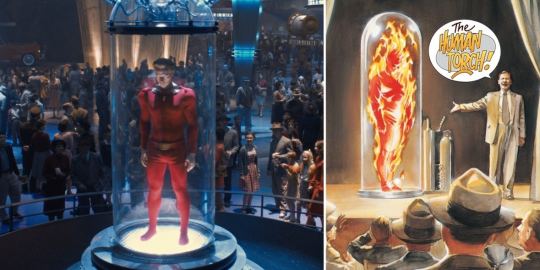
So yea, I wish I had more to say but that's about it. Go read Marvels, it's not very long but it's a wonderful encapsulation of everything great about the 40s-60s era of Marvel.
11 notes
·
View notes
Text
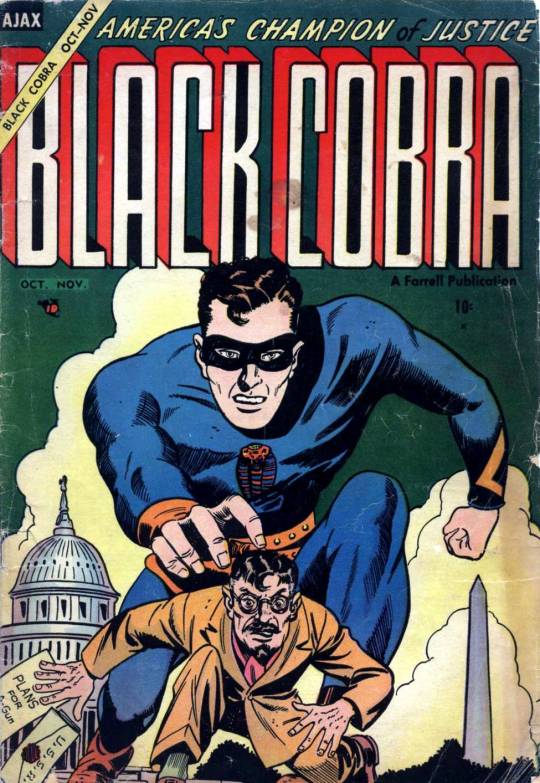
Black Cobra (Ajax-Farrell) #1 (Oct.-Nov., 1954).
Debuting when several companies, including Timely/Atlas/Marvel, tried - unsuccessfully - to bring back superheroes, the Black Cobra lasted a mere three issues.
By day he was just Steve Drake, ordinary FBI agent. But when duty called, Drake donned his costume and smashed Commies left and right as the Black Cobra.
He did not have any super-powers. However, he did have a bullet-proof costume made of a material of his own invention. The soles of his boots had suction cups which enabled him to run down walls (never saw him try to run up, though).
He also had a tricked out convertible, and a sidekick named the Cobra Kid. Other than their names, they did not have any snake-like gimmicks for abilities.
This is actually the second Black Cobra of the Golden Age. The first debuted in Dynamic Comics #1 (October, 1941) from Chesler/Dynamic.
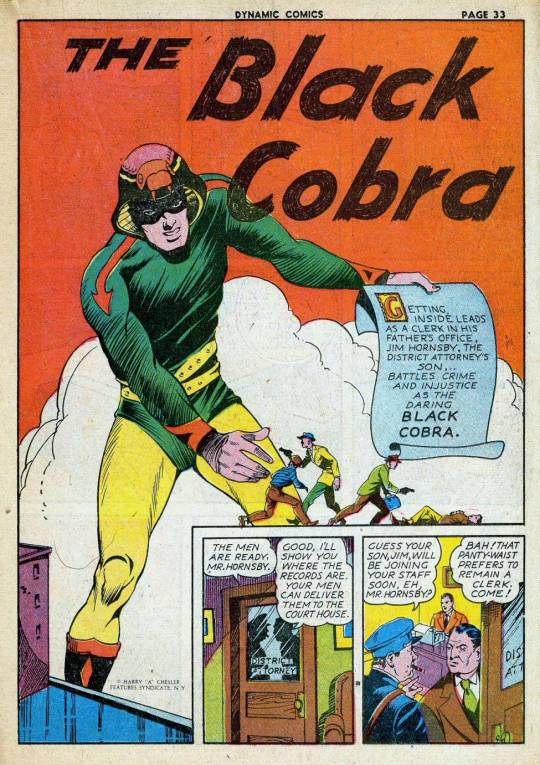
At least this guy looked more like a cobra with that weird hood he wears, but he still had no snake-gimmicks or any super-powers.
This Black Cobra was Jim Hornsby, son of the DA, who didn't seem to think much of his offspring.
After appearing that one time in Dynamic Comics, the Black Hood disappeared for a few years until Captain Flight #6 (January, 1945). His original story was reprinted, albeit with the costume recolored: his tunic was now black, and his pants were red.
Despite the blurb at the end of his story saying he'd be back in the next issue, Black Cobra skipped Captain Flight #7. He was back in #8, this time with his costume colored blue and red, and with his sidekick, Cobra Kid (really his little brother, Bob), at his side. This story was reprinted in the 1954 issue above, with the costumes changed and Cobra Kid being some office boy he knew.
Cobra Kid was missing in #9 (the narration said he was on vacation), and Black Cobra sported an all-blue costume, similar to what the second Black Cobra wore.

Black Cobra and Cobra Kid knocked Captain Flight off the cover of his own book with issue #10. I guess since the boys were flying their wicked looking Cobra Jet (it's first - and only - appearance), and keeping with the aeronautical theme of the book, this was allowed. Oddly enough, there was no Black Cobra story in this issue.
The duo's final appearance was in Captain Flight #11, which was also the last issue. I guess the good Captain was informed ahead of time, because he wasn't in the book at all. His replacement was some undersea hero named Torpedo Man. The Cobra duo both wore all-blue ensembles this outing, but the costumes looked bulky, like they were tailored sweatsuits.
There was never an origin story for either version of Black Cobra or Cobra Kid. They just showed up on the scene and everyone knew who they were. Story context indicated that they had been crime fighting/Commie bashing for quite some time.
8 notes
·
View notes
Text
You know I feel like whenever people talk about something that's been going on so long the quality has decayed because the creators just keep throwing out more stuff, they're usually talking about long runner cartoons like Spongebob or Fairy Odd Parents, or shows that went way past the point of original planning and lost the original plot like Walking Dead or Game of Thrones.
But you know what's probably the ultimate example of "We've been going so long and through so many writers we've lost all semblance of sanity"? Fucking comics. You have any idea how absolutely deranged mainline DC and Marvel have gotten over the years, using the same narrative for their main titles for so long?
Eddie Brock got retconned into having cancer, then retconned into thinking he had cancer because the symbiote wanted him to think he had cancer so he wouldn't take it off, only it turned out it did so so well it actually gave him cancer
Wally West once accidentally murdered a whole bunch of superheroes at a superhero mental health facility because his powers randomly overloaded in a way that never happened before or since. It was a whole mystery as to who could've done it and not only was Wally not one of the suspects the whole time, he was thought to be one of the victims, and there was absolutely 0 foreshadowing or clues to any of this being the case.
Jason Todd initially came back to life because a multiverse variant of Superman (Superboy Prime, long story) punched reality so hard it retconned him into never dying in the first place. Except everything else played out the same so he literally had to break out of his own coffin even though he never died.
Scarlet Witch and Quicksliver have been retconned back and forth from being Magneto's kids like a dozen fucking times. And note, the idea that they could be his kids in the first place was itself a retcon since they were initially labeled as being the kids of two completely different superheroes from Golden Age.
The symbiotes went from being "Strange alien slimes that act as symbiotic suits for people" to being the spawn of the god of darkness, who's original appearance for them was... a bunch of dragons. Not the symbiotes possessing dragons just... symbiotes perfectly formed into the shape of dragons. And two of these dragons wound up on Earth in ancient times and were the basis for Grendel and his mother from Beowulf.
Spider-Man once discovered Gwen Stacy had an affair with Norman Osborne, and because of the goblin formula in his body the kids from that affair aged rapidly to adults who Osborne then sent to kill Peter by telling them that Peter was their father and killed their mother. Mary Jane even told Peter she knew about the affair beforehand... except this was so unpopular it got retconned to being even more ridiculous, because actually the affair wasn't real, Norman had Mysterio hypnotize MJ into thinking it was real by disguising himself as her therapist, the kids were actually clones he made (and weren't in on any of this), and the whole thing was just a needlessly elaborate bit to fuck with Peter Parker.
In both DC and Marvel vampires are real. Not like, "there was a scientific experiment that made someone with vampire-like abilities" (Even though this has happened in both. Characters like Man-Bat and Morbius just coincidentally super-scienced their way into similar traits), not any kind of mutant or metahuman infection, but like, just normal, Bram Stoker-style vampires are real and always have been. Dracula is a character in both. Hell in Marvel he fought alongside Captain America in World War 2 against the Nazis. Jubilee got turned into a vampire for a while because Dracula's son bit her.
#comics are fucking weird#Honestly I maintain that though good stories do come up now and again dc and marvel comics are best used as a mythos to draw from#because all this happening in the same universe is absolutely fucked man#DC comics#Marvel#spoilers for a lot of events#long runner shows#comic books
2 notes
·
View notes
Text
DC Legends: The Justice Society of America
The Justice Society first appeared in 1940 as the first ever teamup of superheroes in the comics. In the Silver Age, it was replaced by the Justice League, and the name has since become a team made up mostly of Golden Age heroes and their successors.
The original roster included Doctor Fate, Hourman, the Spectre, Sandman, Al Pratt's Atom, Jay Garrick's Flash, Alan Scott's Green Lantern, and Carter Hall's Hawkman. The team has since expanded to include Hawkgirl, Black Canary, Captain Marvel, Starman and Stargirl, Johnny and Jakeem Thunder, Doctor Mid-Nite, Atom Smasher, and so many others.
Honestly, if I were making a DC Universe, I would take the time to create a Justice League, and then take another stretch of time to create a Justice Society, probably set twenty to forty years in the past, where most of those characters would have come from. I'd probably then do a later series where Stargirl and the other successors form their own team in the present.
As for casting, it would be simply the cast members cast as each member already established. As for the starting roster, Jay and Alan are for sure, as are Hawkman and Hawkgirl and Doctor Fate, Starman feels a bit too important to leave out, and maybe the Spectre as a mysterious benefactor bringing them all together. Vandal Savage would be my main villain for the first teamup movie, with maybe a second phase leading to Eclipso as the second movie.
#justice society of america#dc comics#casting#jay garrick#alan scott#al pratt#hawkman and hawkgirl#doctor fate#sandman#hourman#the spectre
0 notes
Text
Comics read this past week:
Marvel Comics:
Sgt. Fury and his Howling Commandoes (1963) #20-21
These issues were published across May 1965 to June 1956, according to the Marvel Wiki. Both were written by Stan Lee and penciled by Dick Ayers. Issue #20 was inked by Frank Giacoia and issue #21 was inked by Carl Hubbell.
Fantastic Four (1961) #21
This issue was published in September 1963, according to the Marvel Wiki. It was written by Stan Lee, penciled by Jack Kirby, and inked by George Bell.
I thought I’d finally read this before picking Nick’s stories as an agent of S.H.I.E.L.D. in Strange Tales (1951) back up- this was the first appearance of Nick Fury in the main modern continuity, not in stories taking place back during WWII. This single preceding appearance presented Nick as a C.I.A. agent and Colonel before he was recruited to be the director of S.H.I.E.L.D. in Strange Tales (1951) #135, published in May 1965.
The story was about the Fantastic Four fighting the Hate-Monger, who for a time had the team under the influence of his Hatred Ray. I was surprised to learn Nick had this history with a story about combating racism.
I was particularly charmed by a moment when Johnny and Reed were no longer under the influence of the ray and were luring Ben Grimm into a trap so that they could cure him too. Despite having no qualms about fighting Johnny himself earlier, Ben changed his tune when he saw that Reed had Johnny in a chokehold and heard Johnny crying out, “Help me, Ben! He’s tryin’ to kill me! Help!” Ben charged and yelled, “You skinny creep! I’ll teach ya to pick on a kid!”
the Human Torch story in Strange Tales (1951) #114
This issue was published in August 1963, according to the Marvel Wiki. The issue credits it as written by Stan Lee, penciled by Jack Kirby, and inked by Dick Ayers. The Grand Comics Database also lists Jack Kirby as an uncredited co-plotter.
I also thought I’d knock this of the list of stories I should probably read- this issue was a test for bringing back Captain America, who would later first actually reappear in The Avengers (1963) #4, published in January 1964, and that hadn’t been published since 1954. The story has Johnny Storm fight a villain pretending to be Captain America and ended on the note of asking readers if they wanted to see the character return for real. I’ll note that The Avengers (1963) #4 presented Steve has having been frozen in ice since 1945, and that I believe later comics will establish that the Golden Age appearances of the character after that point in time were actually successors to the name. This story is vague about how long it’s been since Captain America has been seen.
At the beginning of the issue, Johnny says, “I used to read his adventures when I was a kid!” Susan Richards refers to Cap as an “old comics magazine hero.” And another kid exclaims, “He’s alive! He’s really alive!” seemingly referring to both that Cap’s not fictional and that he’s going to be “at the antique auto show in town” that day. Going to see him, Johnny thinks, “Where has Captain America been all these years? Why does he decide to show up now?”
After the imposter Cap’s public appearance, Johnny’s girlfriend Doris says, “He’s my idea of a real man! Handsome… modest… strong! *sigh* I wonder who he really is?”
Even the villain exalts Cap’s virtues. The imposter Cap says, of his crimes, “This is a far cry from the noble, heroic Captain America exploits of years ago… But this little deed will be far more profitable than any others ever were! It’s a shame to tarnish the glorious Captain America legend�� the legend of heroism and self-sacrifice… But legends don’t pay off!”
And at the end of the issue, after ‘Captain America’ has been revealed to actually be the Acrobat and sent to jail, Johnny goes through his “prized collection of old comic magazines.” Despite that his girlfriend had been wondering who Cap really was earlier in the story, Johnny says, “Boy! I sure dug this guy the most! I remember how he used to secretly change from Army private Steve Rogers to the great C.A.! *sigh* Wonder what ever did become of him? Is he still alive? Will he ever return? I’d sure like to know!” When Steve is actually really brought back to publication later on his secret identity will be a secret to the public, not having been revealed through his comic books.
DC Comics:
Martian Manhunter: American Secrets (1992) #1-3
These issues were published across August 1992 to January 1993, according to the Grand Comics Database. All were written by Gerard Jones, drawn by Eduardo Barreto, and colored by Steve Oliff. Each issue was 46 pages.
This was a strong, dense story. I’m not going to try to summarize it. I’ll just note some parts that stood out to me.
In issue #1 while watching a game show on TV, and after having been offered a connection with a prostitute, John thinks, “This is what the cold brings. Companions on order. Companions that come alive with the snap of a knob. Companions. Contests. So they can cheer for the meaningless victories of strangers. Manufactured families. Staged communications. It’s a cold world for a stranger. […] When on Earth, do as the Earthlings do. But why do they give this so much power?” Later, upon seeing Playboy-style magazines at a newsstand, he asks, “Who buys all these magazines? What are they looking for? Like these. Who buys these?” He’s told, “Guys. Normal guys.” And John asks, “Is it warm there… in the magazines?”
In issue #1 John is investigating a murder, but not by normal procedure. He follows around things that are seemingly minute and unconnected. He’s trying to both make sense of the case and humanity; what sticks out to him are not what would stand out to a human. Of this, he thinks, “What trail am I following? A word here and a hunch there, seeking the undefinable, not Earth methods. Mars methods? I don’t remember enough to know.” But because this is a bizarre, unnatural case, this process keeps him on the right trail.
And in issue #2 a stand-in for Bill Gaines gives a little girl a copy of All-Star Comics (1940) #5 and says, “Here, kid. You need this.” She says, “But I don’t read comic books! They’re not educational!” He tells her, winking, “That’s what you think.” Notably this story takes place in 1959. Both the real world 1954 Senate Subcommittee on Juvenile Delinquency hearings about comic books, which Bill did terrible at and which lead to the Comics Code Authority, and the fictional shut-down of the Justice Society of America by the House Un-American Activities Committee are brought up in the story.
Superman: House of Brainiac Special (2024) #1
This 38-page one-shot was published in April 2024. It contained a story about Brainiac’s history with the Czarnians, which was written by Joshua Williamson and drawn by Edwin Galmon; a story about Bibbo and Perry White’s mayoral campaign, which was written by Mark Russell, drawn by Steve Pugh, and colored by Jordie Bellaire; and a story about Amanda Waller, which was written by Joshua Williamson, drawn by Fico Ossio, and colored by Rex Lokus.
I liked the background of Brainiac being confused by a father’s desperate attempts to save his doomed children and realizing from there that there’s something he doesn’t understand, a gap in his knowledge. But I think his history with Lena would be a part of how these feelings of wanting a family developed for him, so it will be a weak point of the portrayal of what’s meant to be a significant part of his characterization for this event if that time period is never flashbacked to and depicted.
I also liked the ultimate conclusion that was come to in the Bibbo story- “A neighborhood’s a lot like a person. Always changin’. Because it’s growing. We change because we’re alive.”- and I wonder if that specific sentiment will be relevant to where this Brainiac story goes.
Fawcett Comics:
the Captain Marvel stories in The Marvel Family (1945) 16
This issue was published in October 1947, according to the issue cover date. It contained 2 stories with Captain Marvel, one 8 pages and one 9 pages.
1 note
·
View note
Text
@leesbian42 @teehhhhhhhhhhh @fandomfive39 and @chaoticallyfluffy expressed their interest in my sharing of Marvel Lore
I'm going to stick to some basics and not get into every storyline of Captain Marvel but I will go through general eras and the who's who of them. Now, I am no encyclopedia nor do I claim to know everything about the blorbos, I'm just one of the more well-read of their fans. If anyone else wants to butt in with their own expertise or correct me where I messed up a bit, please do! Better for everyone seeing this post to have something to read up on to save them the hundreds of appearances of these characters, the propaganda, the classic 40's racism, and the shifting timelines and canons!
For starters, I'm just going to stick to good ol' Fawcett comics on this reblog
So, just to get it out of the way, Whiz comic was pure unfiltered Golden age nonsense like most every early comic and thats the magic of Whiz. It was fun and unapologetically so for basically it's entire history, not really getting a chance to modernize thanks in large part to DC suing them out of publication before they could follow the changing trend.
We start in Whiz Comics #2, officially there is no #1, and we meet Billy Batson. He's passing out his newspapers in the rain when hes approached by a trenchcoated man with no discernable features who asks why hes out so late and Billy responds that he is homeless and sleeps in the subway. The man tells Billy to follow him, they get far into the subway and board a strange train that takes Billy to the dwellings of the Wizard Shazam who do a quick lore drop for the kid. Basics are established, Billy is an orphan and his scummy Uncle Ebenezer stole the inheritance his folks left behind.
Shazam gives Billy his powers and sends him on his way, Billy then overhears a plot by some men to take over the radio waves and goes into Whiz Radio to tell the owner, Mr. Morris, what he heard. Mr. Morris is skeptical but tells Billy if he can prove what he says he'd give the kid a job working for him. Billy goes off, turns into Captain Marvel for the first time, and finds and destroys the machine that was going to take over the radio waves, curtesy of the brilliant mind of Doctor Thaddeus Bodog Sivana's criminal scheming. Billy gets his job and Captain Marvel is established.
From then on is a flurry of fun whimsical adventures where Captain Marvel and Billy Batson work as a team to fight evil and protect the defenseless, a point is made many times over that Billy Batson and Captain Marvel are different people. This is shown through Cap appearing semi-translucent to only Billy like a ghost to encourage or help him, times where Captain Marvel and Billy physically were different people, and the Captain referring to Billy as a separate person and vice versa. They basically swapped places.
Before the iconic Big Three of the Marvel family we had the Lieutenant Marvels, named after creators in Fawcett publications, all of which shared the name Billy Batson in the comics. The country livin' Hill Billy, the rounder Fat Billy, and the tall Tall Billy. They took these nicknames when they met because they agreed that our Billy Baston should keep his normal one since he was the most popular with his own show and such, they were soon also kidnapped and strapped to a log on a cutting line about to be split in two and Billy's voice alone wasnt loud enough to go over the sound of the blade to summon Shazams powers so the boys yelled in unison and all got powers. Thus Tall Marvel, Fat Marvel, and Hill Marvel came to be and Billy got three new friends.
Freddy Freeman soon joins the ring when, during a scuffle with Captain Nazi, the villain goes crashing into the water nearby a man out fishing with his grandson, they try and pull him out and the old man is killed and when the boy strikes him with an oar in retaliation he is tossed aside and hurt badly from the blow. That boy was Freddy and his grandpa, the latter now dead while Freddy sits at deaths door. Marvel saves him and tries to bring him to hospitals who turn him away because the boy is a lost cause, so he brings him to the Wizard pleading with him to help him save his life. Shazam advises him to share his power and when Freddy says Captain Marvel he is mostly healed and turned into Captain Marvel Jr. He still has a limp and needs a crutch to get around but that is the origin of Marvels long time sidekick and Billy's best friendship with Freddy Freeman.
What also comes about in this era is the introduction of Mary Bromfield, Billy Batson's long lost twin sister who was swapped with a different kid that died in her care when they were six months old and in an orphanage by one Nurse Primm and raised by the Bromfield family while Billy was put into the care of their uncle after their parents died. Mary was raised without knowledge of any of this and neither was Billy until, while covering a sort of game show segment for Whiz, he's called away to talk to a woman on her death bed who happens to be Nurse Primm herself who admits to what she did and gives Billy a matching locket to help him locate Mary. He returns to the show and realizes the girl there is his sister. He saves her from kidnappers and reveals his identity to her and she wonders that, since shes his twin, maybe saying Shazam would transform her too. It works, and thus Mary Marvel is born! The Marvel Family has its members rounded up!
He's been mentioned before here, but Mr. Morris is the owner and head of Whiz Radio, he also functions more often than not as a sweet paternal figure in Billys life and is really nice to him. He himself founded the station out of his own love for the medium, having been a HAM Radio kid in his time and falling in love with the craft then and there. He does what he can to make the station better and is more than a successful entrepreneur in the risks he takes from his trust in Billy to many times he almost fell for someone's scheme trying to gain more capital or help out the station.
He also has a niece and nephew! Cissie and Pete Sommerly, Cissie being a rarely appearing girlfriend of Billy with only a dozen appearances to her name. Of what few times I do remember her she has been saved by Marvel one time I remember, participated in and won a gardening show, and gone on a sweet ice cream date with Billy. They were a swell couple.
Tawky Tawny is the titular talking tiger of the Marvel family, best friends with Billy, has quite the odd origin. Born a normal tiger in India, his mother was killed by a hunter when he was a cub. Later on the son of a missionary, Thomas Todd, adopted the cub and called him Mr. Tawny. When a man in the local village was killed by a tiger the people there blamed Tawny so Thomas fled with the cub in tow, meeting an old hermit who had been a brilliant scientist who made a serum that could make an animal more human so that they might speak. Given to Tawny, he returned to the village and killed the rogue tiger that actually killed the previous man and vocally proclaimed his innocence with the true culprit killed.
When Thomas' father was transferred he was forced to leave Tawny behind, who grew the rest of the way up with the hermit, becoming bipedal and the size of a man with all his tiger features still intact since he'd taken the serum so young. Wanting to join civilization, Tawny boarded a ship headed to America and found himself in Fawcett City, where he accidentally terrified the locals and got placed in the zoo by a confused Captain Marvel. He broke out and incidentally ended up stealing his iconic plaid green suit clothing when he scared the store keep away again, this time having the chance to explain his desire to live with humans to Captain Marvel and get his chance. He became a museum guide but had many other jobs like private detective, clothing model, and actor for a short time before he left that role.
Another icon of the family is Uncle Dudley, or Uncle Marvel as he would fraudulently claim before the kids let him into the family. He found a dairy Mary kept of her good deeds as Mary Marvel and figured out the Marvel Family secret, soon claiming to be their uncle and actually becoming a part of the family because, though a fraud, the man was too lovable to the kids and they went along with his lie. He'd always been more comedic relief than not and had his sweet moments with the family, his running gag being "turning into" Uncle Marvel by revealing his homemade Marvel uniform but never having working powers because his "Shazambago" was acting up. He had a niece as well, Mary "Freckles" Dudley or Freckles Marvel, a comedic relief character in the same vein with Mary specifically. Dudley would found Shazam Inc, where Dudley would work as the Marvel Family's manager.
Last but certainly not least is the Wizard himself, Shazam. Originally named Shazamo, he discarded the O after he representing figure Oggar turned evil, making himself just Shazam and leaving Oggar as a smaller time villain with a grudge. An ancient Wizard who had spent the last few thousand years fighting the forces of evil, he reveals himself as an ancient Egyptian Wizard who had used the powers he bestows onto Billy Batson in his crusade. Soon after bestowing his magic, he is killed by a giant rock from the Rock of Eternity falling on him and crushing him as lightning takes Billy away and back to Fawcett. He remains and reappears many times as a ghost, sometimes through the lighting of a brazier in the RoE but sometimes entirely on his own.
This is the original Marvel Family as they were in Fawcett comics, barring the villains and reoccurring side characters that aren't as important figures to be mentioned here. Newer retcons and additions would add to this roster and take away members as they are quietly dropped from writing, the Lieutenant Marvels dropped almost entirely outside a Multiversity cameo and Dudley getting few modern appearances while characters like Blaze and Satanus are made into the Wizards blood children and Kid Eternity of a different Fawcett publication would be made into Freddy's brother.
I'll get into villains in another reblog attached to the previous post, tell me if theres anything else y'all wanna know!
can someone mansplain the entire history of Billy Batson Captain Marvel, the Shazamily, and Fawcett City to me??? or at least like. . . the main parts
#Marvel family#dc Marvel family#billy batson#mary batson#mary bromfield#dudley h dudley#freddy freeman#uncle dudley#tawky tawny#mr morris#shazam#fawcett comics#dc comics#dc
316 notes
·
View notes
Note
I really, really love your fanfic Split. You tackle the concept of identity quite well, and it really feels authentic to the spirit of Billy Batson and Captain Marvel. You capture each character's voice so well that it is seamless when read; I could hear and visualize each character speaking or doing an action.
I wonder how you realistically portray the internal and external conflicts regarding their gender, autonomy, and bond.
Did you draw it from your own life, research, or people you know? It is quite a personal question you do not have to answer; I was just curious. I would also like to ask what would be the best way to portray that relationship accurately—as you do—so the process feels more like representation and not appropriation. Any advice would be greatly appreciated!
Oh wow, thank you so much! This honestly made my day!💜💜💜
I'll try my best to answer your questions and give some tips. But some things are just hard to put into words you know?
Under the cut because it got pretty long.
I would say that I don't often base things purely on my own experiences, but my life, the stories I've heard or read, the people I've met, all inform how I write and what I write.
So I am Agender and I was assigned female at birth. I'm also aromantic and asexual, so I have spent a lot of time in queer spaces both online and irl. Which means ive had a lot of opportunities to talk to and learn from people with different experiences with gender and sexuality than my own. My journey of self discovery was honestly pretty easy with very little gender dysphoria and a lot of acceptance from people around me.
When I wrote Captain Marvel having very little connection to gender with no real preference for pronouns, just sort of accepting people's assumptions of his gender based on his looks, that's me. My connection to gender is extremely loose, basically nonexistent, but i dont really care if people know that or not. It's not the most common experience but it is my experience. And I thought it would make sense to apply that to my version of Captain Marvel because he has had many different forms, but his expression depended on his hosts and their ideas of gender.
When I'm writing about Billy’s struggles with gender, I often take my own experiences of being AFAB mixed with things I've learned from the trans masc community. I'm not trans masc myself, but there are certain parts that resonate with me that I include. Honestly I'm often nervous when posting chapters that focus heavily on that because, like you, I want to be both accurate and respectful. But so far the responses I've gotten are overwhelmingly positive.
And my thoughts on Billy and Captain Marvel’s relationship has evolved since I first started writing them. They know each other completely and they wouldn’t be who they are now without the other’s influence. The character of Captain Marvel is incomplete with Billy Batson and vice versa. Portraying that in a fic has been one of the major challenges of writing Split but is also the main reason the fic exists in the first place.
Drawing on older golden age comics, Billy and Captain Marvel are basically the ultimate tag team and each other’s biggest supporters. But they had distinct differences and on rare occasions got into arguments about how to live as one person.
When I write them, I try to highlight that Captain Marvel is more mature with a lot more lived experience that he draws on. But that doesn’t mean Billy is immature. Far from it. But he is a kid who doesn't really trust most adults and that leads to him making certain decisions that are more reckless.
In Split they are trying very hard to keep up appearances, but despite their combined experience neither really knows what would be considered normal. There's a certain amount of being out of touch or misinformed that makes their characters more endearing to me.
If you want to write them yourself (and I would always encourage people to go for it!) I suggest deciding early on what parts of Billy cross over to Cap. Figures of speech (ex: holy moley!), body language (do they both put their hands on their hips when confident or rub the back of their neck when embarrassed?), morality (what lines can and can't be crossed), and certain likes and dislikes would be a good start. From there decide what's unique to each of them. For example I often have Cap be more skilled at/knowledgable of magic even if Billy also studies magic, but is also pretty shy around other people. Billy on the other hand is more likely to curse and question authority but is also better at talking to people and connecting with them.
As a final note of advice, if you want to write about identities or experiences that you don't have: read about and talk to people who do. Whether it's fiction, blog posts, biographies, academic papers--all can help you get a more well rounded idea of what it's like and how you respectfully portray it. If you're still unsure, look for a sensitivity reader who can look over your work and help you make your story the respectful and realistic portrayal you want it to be. I'd even be willing to do that for you for things I felt qualified for. I know it's hard to take that leap sometimes but I promise it's worth it!
Whew! That was long and maybe a little rambling but I hoped it answered your questions!
#fanfic asks#my writing#Billy Batson#shazam#dc captain marvel#ask me whatever you want y'all#lots of rambling that i hope makes sense
46 notes
·
View notes
Photo
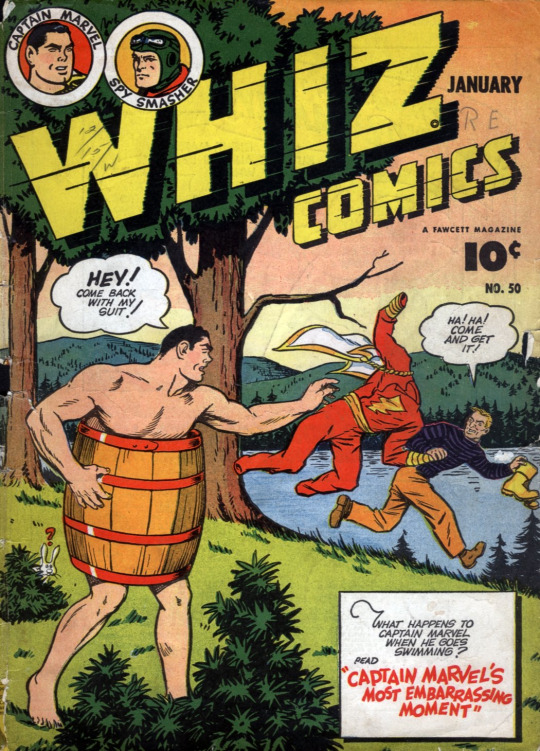
All right, since I’m in the middle of a flare and have to work manual labor for the next four days despite it, I figured I would make myself -- and hopefully other people -- laugh by talking about one of my favorite OG Captain Marvel stories. Namely, from Whiz #50, with a cover date of January, 1944, meaning it was probably produced sometime in late 1943.
I want to share it because why not, this is some absurdly charming stuff.
I’ll get more into why it’s one of my favorites as we go, in the form of running commentary. So, full story (with said commentary) under the cut. If you wanna just read the story without my commentary, stick to the pictures. XD

First, let me say that the cover and splash page definitely live up to the story, though the cover’s a bit more sensationalized. But the premise is pretty damn simple: Our intrepid hero and his newsboy alter ego are on vacation. Cap decides to go swimming. It goes hilariously wrong and thus ensues a bit of a madcap adventure, no puns intended.
Second, the fact that Cap and Billy are depicted as essentially different entities makes what Billy does next the ultimate trolling:
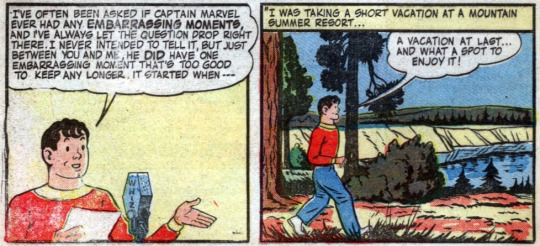
Gee, airing out the stolen laundry on the radio? Really? I’ll leave it up to you, gentle reader, whether Billy actually was trolling his own alter-ego for ratings or whether he was just innocently sharing the story while his other-self winced quietly in whatever ether-space he exists in when not front-and-center.
Either way, I love it.
Continuing on...
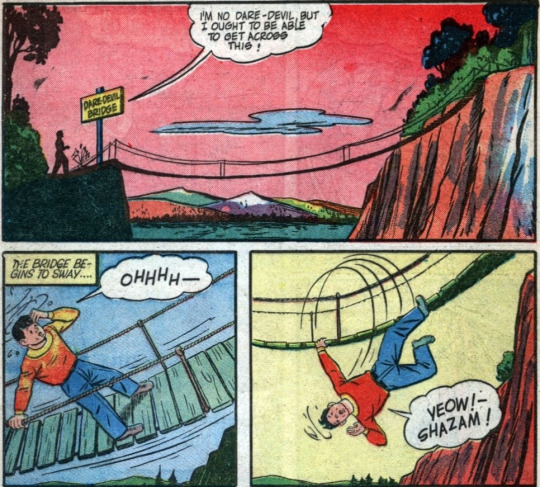
I get a kick out of the fact that Billy’s monologue is that he’s no dare-devil. One, because that’s so obviously not true in any way -- (that kid is awesomely, sometimes recklessly brave on the regular even without Cap) -- but two, because the bridge is actually named Dare-Devil Bridge. We aren’t given any reason why this dangerous potential death-trap is there, hanging without so much as a gate or a warning sign or anything, because we don’t need one. It’s there specifically for what happens next.
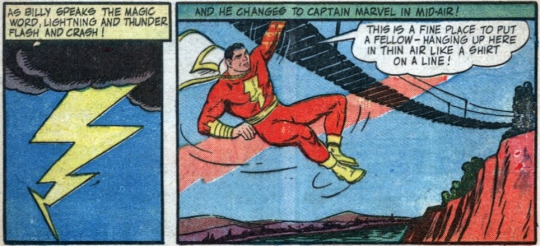
Which, of course, is Billy calling in Captain Marvel, who does some light complaining about the situation Billy left him in. There’s no bite to it, which I find adorable -- Cap actually does get frustrated once or twice in other issues with Billy calling on him for mundane stuff, though he’s never mean about it -- but there is a bit of the sense of being put-upon there that’s just-- I dunno, cute. It’s something I miss a lot in the various post-crisis takes on the character: That duality, that difference in personality, and the way each of them responds to different situations. Often, they’re on the same page, but notably, sometimes, they aren’t.
Someday, I promise, I need to sit down and write how I think that works between those two without being a truly frightening mental illness manifested, what with them being the same person but not the same person. Because I have so many ideas, and I’ve only had since the early-2000s to percolate them. LOL! But until then, just enjoy this.
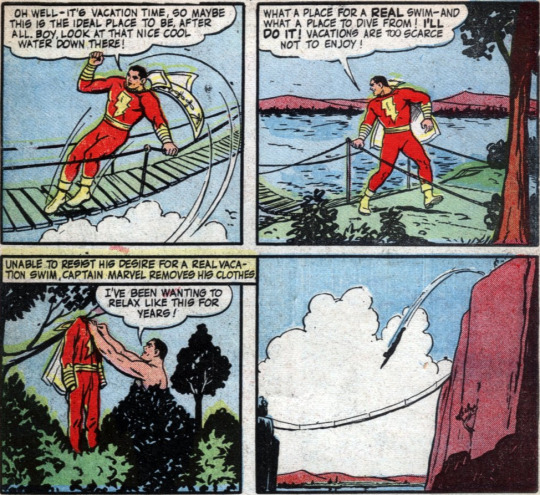
Here is another reason why I love the Golden Age Captain Marvel books and why I love this specific story: This is an absolutely normal, mundane thing to do. It’s the human thing to do. These aren’t the actions of some super-serious superdude. These are the actions of a pretty shockingly normal guy doing something mundane. And a whole story is built around that normalcy.
It’s cute. It’s funny. It’s the reader already knowing that he’s getting himself into a situation that he absolutely could have avoided, but also completely understanding how it happened anyway. It’s pretty brilliant writing: I say this as a pretty damned good writer myself.
So much of the reason why, I think, Cap was so endearing as a hero is that humanity. He’s got pretty much god-tier power in the Golden Age, once his powerset is established. He’s utterly invulnerable to all physical harm while powered up. But-- he’s human. He knows he’s human. He acts like it, and decides, “You know what? I’m going skinny-dipping.”
He and Billy are both characters it’s so easy to empathize with.
Also, a reminder that the art under Chief Artist C.C. Beck is really, really good. (He had a whole stable of artists to help produce this stuff!) Ignoring registration issues on the printing press, the actual line art is amazingly good; proportion and perspective and consistency.
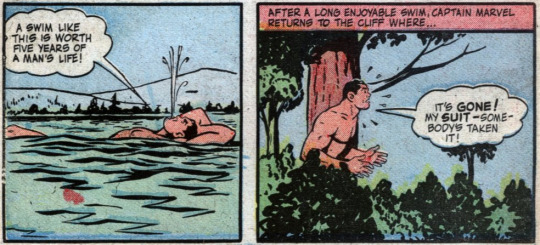
But anyway--Cap does get to enjoy his swim. But, then, oh no.
I love the idea of a world where the prime hero -- and he definitely is in that world -- can take off his suit and go swimming, and where someone else is bold enough to steal the damn suit off of him. The first time I read this, I started laughing here. Not at him, but at the situation he’s found himself in. At the idea that some random passer-by saw Captain Marvel’s costume and went yoink!
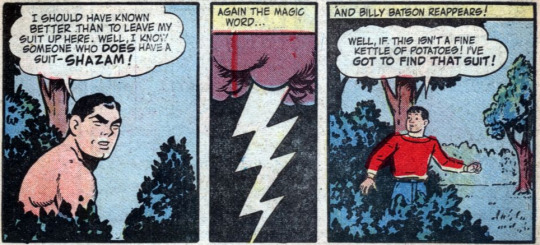
Another thing I love about this particular story is how much Cap and Billy have to work together, just by necessity. Like-- it’s just really good. But anyway, thank everything Billy Batson is on the ball, coming to the rescue.

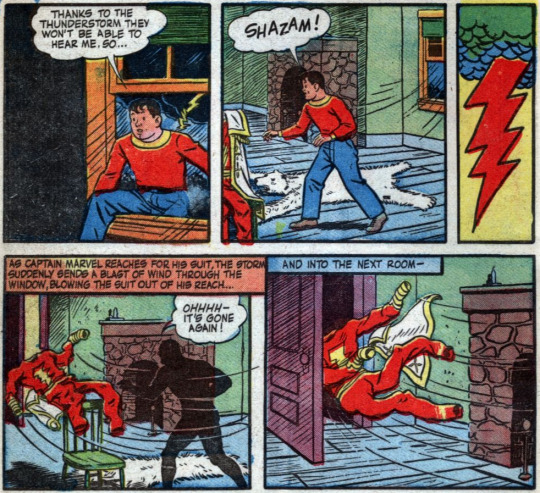
Sheer bad luck via the weather keeps this story rolling along in hilarious misdirections. Realistically, that uniform probably wouldn’t be all buttoned together (we see Cap take off pieces of it aside the pants in other issues, including socks!), but who cares? The point of the story is that giant bear rug on the floor’s gonna get put to use.

Man, when have you ever seen Superman creeping naked through some stranger’s house wearing nothing but a random polar bear because he went skinny dipping? No wonder these comics sold so well. This next panel is when I start wheezing, though, and pretty much keep wheezing.
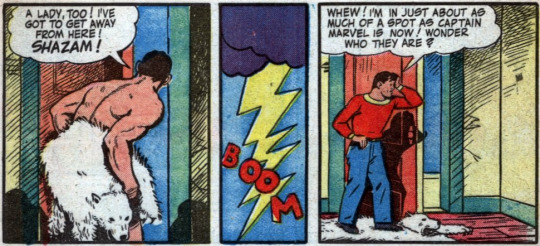
“A lady, too! I’ve got to get away from here!”
I’m dying at this point. That’s such a characteristic response, and yet, I think that’s why it’s funny.
Anyway, because this is an excellent story (I mean this without an ounce of irony, too), our dynamic duo stumbles across a plot in play to rob the hotel they’re staying at.

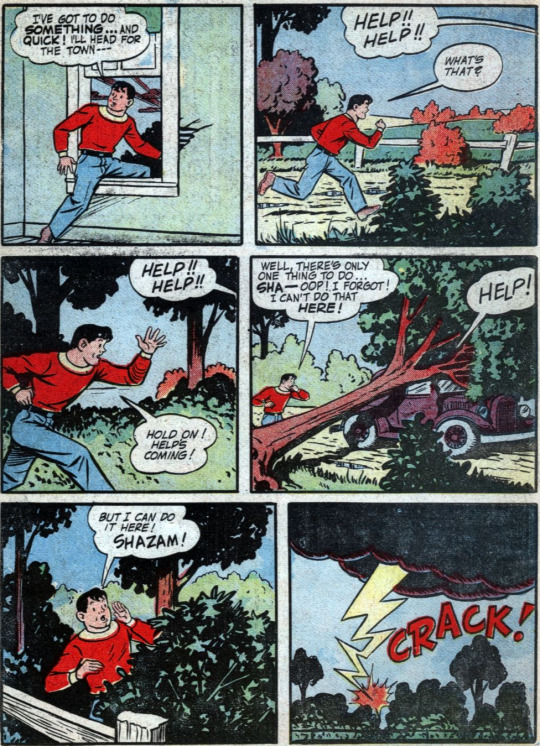
Here’s a big part of why this is such a good tale: Everything fits. Even when it isn’t explained, like Dare-Devil Bridge, it still fits. Why is the tree down? Because there was just a thunder storm, the same one that blew Cap’s suit into the room with the gangsters.
I don’t know if this is Otto Binder’s story, but I wouldn’t be surprised in the least. It’s a complete story told in relatively few pages that accomplishes everything it’s meant to.
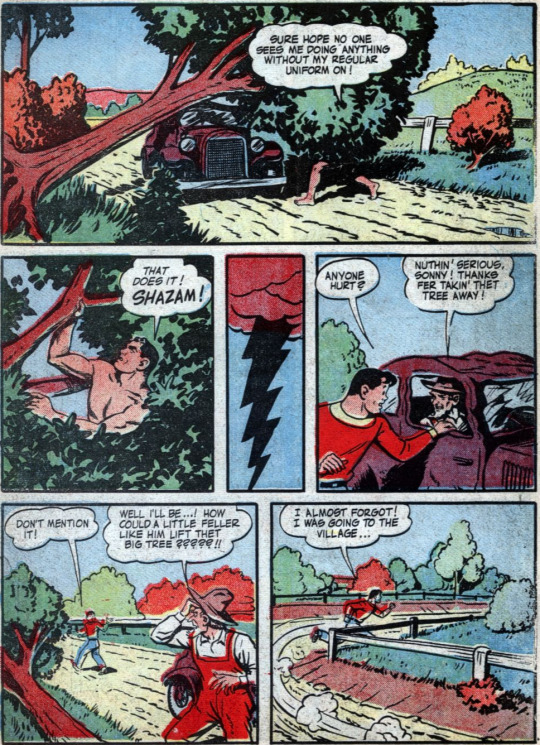
Anyway, using foliage as cover, Cap gets to be heroic----then Billy gets to get back to the business of trying to stop the robbery of the hotel and get his heroic alter-ego dressed again. Which leads to a rather adorable and funny scene of Billy not only trying to describe what Captain Marvel wears, but what size it would need to be tailored in.
(Cap is supposedly a 44 for a suit coat, we find in some earlier appearance, which would refer to his chest size. So, an XL for shirts and suit-coats. He’s a big guy, but he’s actually not a hulking huge guy. But more on that later.)


I love the fact Billy tries to like-- use himself as a model. Maybe in another ten years, kiddo. Billy’s actually pretty buff for like a 12-14 year old, he’s not a scrawny kid at this point, but yeah, no. LOL!
Another thing I also really, really love about this style, though, is that they draw Captain Marvel as being strong, as having a powerful build-- but not as a dehydrated body-builder with deep cuts. He’s got human proportions, regardless of his strength; he’s got a human build, not a superhuman one.
C.C. Beck had a lot of things to say about superheroes who were just muscles on top of muscles, all clearly defined, and he didn’t like it. As someone who first got into comics in the early 90s with Jim Lee’s X-Men--
I do get Beck’s point. I not only get it, but I really highly approve of it. He maintained to the end that he drew (and oversaw) the Marvel family to look like high school and college athletes, and I can see that. I think the one person who’s gotten it right in the modern era is Evan “Doc” Shaner, who did Convergence: Shazam! He not only nailed that strong-but-not-hulking build for Cap, but also how young he looked. College-age, in fact.
But anyway, enough digression into art and why I like this better than most modern takes on the character. Also, that’s just a cute set of panels.
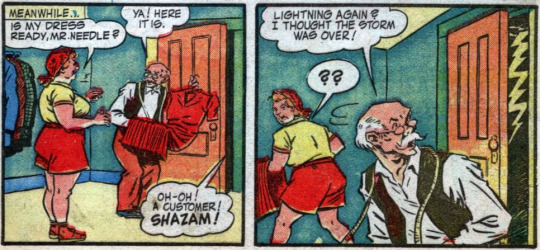
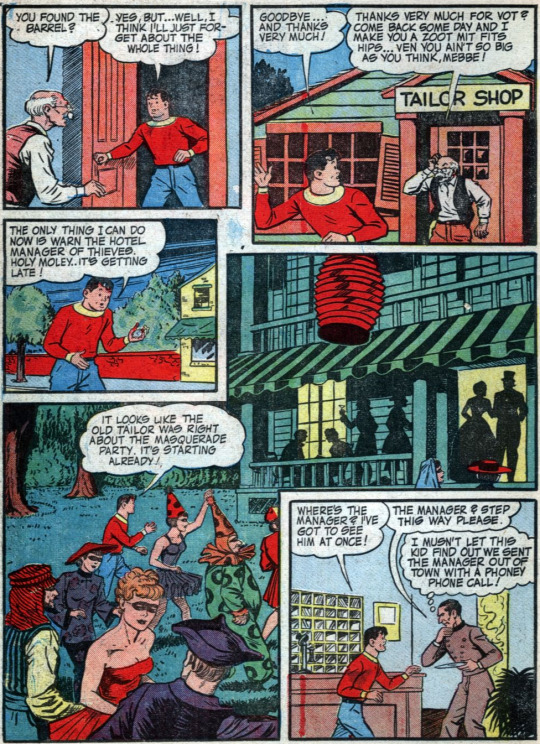
I also like that there wasn’t an easy fix there. Cap’s still in his not-birthday suit, and Billy’s still stuck running around trying to solve the issues at hand. Next comes some other really good panels:
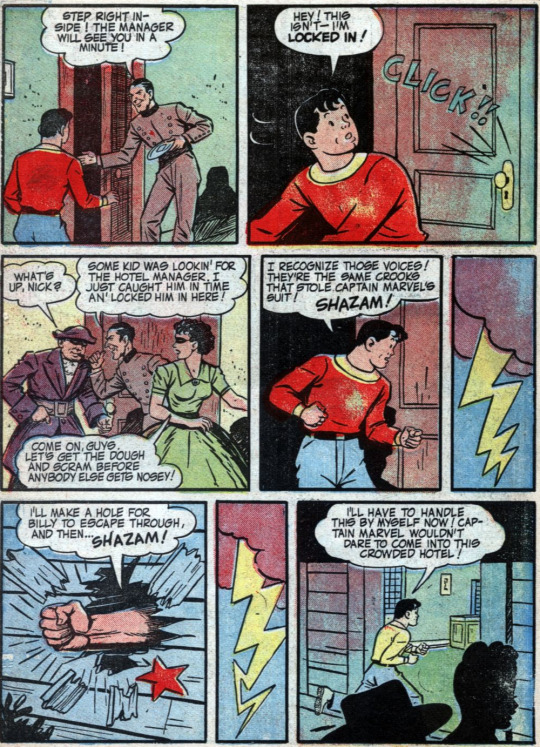
-snorts- He’s locked in. Yeah, that’ll hold him.
Anyway, what I really liked here was again that tandem working; Billy can’t punch through a wall, but Cap can. Cap can’t crawl out while he’s au natural -- well, he could, but he’d probably rather die first -- but Billy’s got no such issue. It’s just fun when you get to see them doing something like that. You have to really think for a minute about the trust each of them must have in their alter-ego.
ANYWAY, we get the rare treat then--
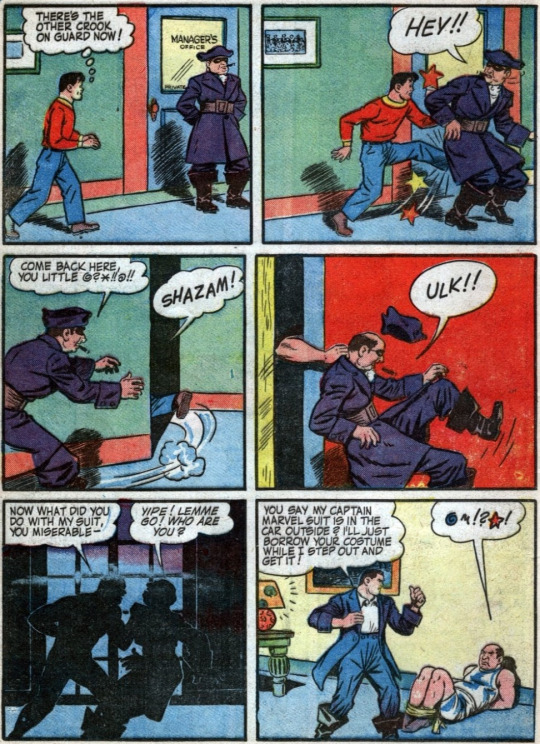
--of Captain Marvel not only yoinking a dude into a dark room, but then stealing his clothes. Except, not his underwear. Because that’s nasty. LOL!
I love that in this series, you do actually get to see him wear other stuff. Go incognito. Get his red suit messed up enough to take it to a dry cleaner’s, wherein he ends up dressed like a musketeer after. Jerry Ordway’s series is, I think, the only other time we see Cap not wearing his famous suit, but it happened enough in the Golden Age that it wasn’t a shock.
Like, I hate to be the one to say this, but I do think DC drops the ball often on just how much you can do with Captain Marvel (or Shazam, depending on timeline, but that’s the wizard’s name to me so mostly I’ll stick with the original name) if you unbend enough to. It’s not just the costume change, or the duality of him and Billy being the same but not, but also his inherent, essential humanity.
But I am digressing again, sorry. XD I just feel strongly enough about these versions of these characters to spend hours writing this.
Anyway, only a single panel later:
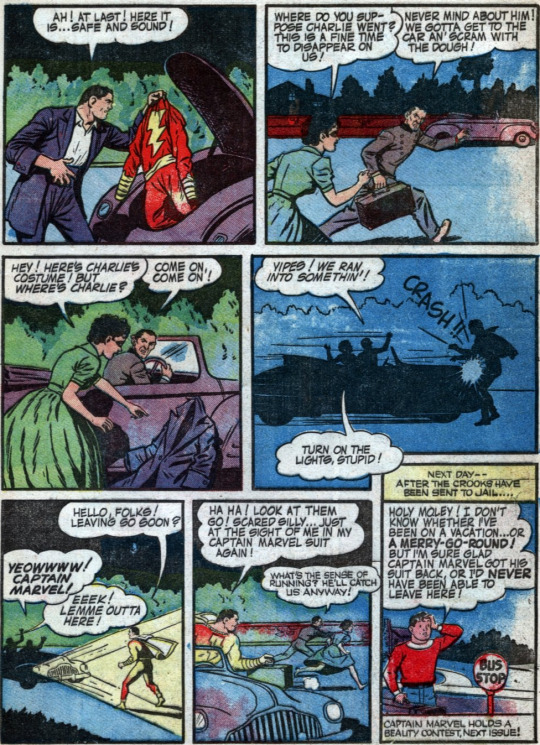
And that’s that! Billy Batson has just outed his own alter-ego’s most embarrassing moment to whomever’s listening to WHIZ radio -- thank everything podcasts and the internet weren’t available then, ha! -- and we get to see a recounting of a very fun story.
Like I said earlier, I love this one for its essential humanity. The hero got himself into this mess, he and Billy got him out of this mess, and stopping the criminals was actually just kind of a lucky stroke thrown in there. But even though Cap got himself into this, the story never treats him like he’s stupid. It never treats him like he’s some kind of idiot. You’re laughing, but-- not in a mean way.
I love how human it is. How complete it is. How genuinely funny it is. It’s a thousand times more funny when you genuinely love and respect Captain Marvel and Billy Batson, too.
Anyway, I hope you enjoyed this dissertation on a skinny-dipping hero. LOL! I enjoyed sharing it with you.
39 notes
·
View notes
Note
Your Top Five Pulp Heroes that you wish were better known? By Pulp Hero fans, I mean. Since pretty much all of them except Conan and Tarzan are fairly unknown.
It’s actually quite hard for me to narrow it down to just five, because I’m having to choose between characters that are my favorites that I wish were more well-known and appreciated (which is all of them), and characters that aren’t quite my favorites but I very much think should have achieved great popularity for a myriad of reasons. So instead I’m going to pick some of each. These are not necessarily ranked by their importance or my personal taste, just 5 characters I felt like highlighting in particular.
Honorable mentions goes to characters I already talked about prior and don’t want to repeat myself on. These aren’t “lesser” picks, just ones that I already talked about: Imaro (who in particular definitely feels like he could, and should be, a pop culture superstar if he was only more well-known), Kapitan Mors (who’s got a lot in common with one of my favorite fictional characters, Captain Nemo, but also has a lot of interesting things going on for him as his own character). Sar Dubnotal (a character that appeals a lot to me and I think should be included much more often in pulp hero team-ups). The Golden Amazon (again, definitely a character that feels like it’s just begging to have a pop culture breakout, even comic books rarely if ever have female supervillains this ruthless and over-the-top), The Mexican Fantomas (who absolutely deserves a better name than what I’m calling him here, because he’s incredibly awesome and leagues ahead of just being a knock-off). And of course my homeboy, The Grey Claw, whom I would consider Number One of the list if it wasn’t for the fact that his obscurity has left him untouched by copyright and I got plans of my own for the character that wouldn’t be possible if he was more well-known, so I guess I’m ultimately glad he’s obscure (even if I’m still bothered by how little he’s known).
Allright let’s go:
Number 5: Sheridan Doome
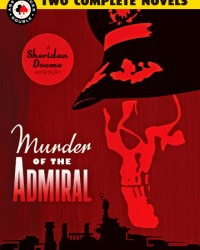
Sheridan Doome appeared in fifty-four stories and three novels from 1935 to 1943. As chief detective for U.S. Naval Intelligence, Lieutenant Commander Sheridan Doome’s job was a grim one. Whenever an extraordinary mystery or crime occurred in the fleet, on a naval base, or anywhere the navy worked to protect American interests, Doome was immediately dispatched to investigate it. Fear and dread would always precede Doome’s arrival in his special black airplane. For, in an explosion during WWI, he had been monstrously disfigured.
He was six feet two inches tall; had a chalk-white face and head. It appeared as though it had once been seared or burned. For eyes, he had only black blotches; glittering optics, that looked like small chunks of coal. His nose was long, the end of it squared off rudely. He had no lips, just a slit that was his mouth. His neck was long, as white and as bony as his face…. Sheridan Doome looked more like a robot than a human being. He was tall and ghastly; his uniform fitted him in a loose manner. Long arms hung at his sides; his face was a perfect blank. He had no control of his facial muscles; consequently, his countenance was always without expression, chalky and bony.
But behind the ugliness was a brilliant mind. Sheridan Doome always got his man. Before Sheridan Doome became a staple in the pages of The Shadow magazine, two Doome hardcover mysteries were written in the mid-1930’s by acclaimed hard-boiled author Steve Fisher (I Wake Up Screaming) and edited by his wife Edythe Seims (Dime Detective, G-8 and His Battle Aces). Age of Aces now brings you both books in one huge double novel, presented in a retro “flip book” style. This book is currently Out of Print.
I sadly don’t have any more information on the character other than this. The book is unavailable for me to acquire in any capacity, and the text above is taken from the Age of Aces website as well as Jess Nevins’s personal profile for the character. I’m not even sure if any of those 54 stories even exist anymore, since although he was published as a backup in Shadow Magazine, there doesn’t seem to be reprints of them anywhere, at least as far as I can find, and the original Shadow magazines have largely turned to dust by now.
A character who combines aspects of The Phantom of the Opera and The Shadow, whose adventures are set in a backdrop that can easily lead to ocean adventures? That’s like, what, three of my favorite things in the world combined. I really, really wish I could at least read the stories this character stars in, but as is, this description is all I can provide. Again, time really has been cruel to the pulp heroes.
Number 4: Harlan Dyce

This is another character I’ve only been able to learn about through Jess Nevins’s archives and have not been able to attain any further information on, which is sadly the case with a lot of pulp heroes that nowadays only seem to exist as footnotes in his Encyclopedia or records in libraries. I don’t post more about these characters because I really would just be copying the stuff he wrote without much to justify me quoting him verbatim, and I hate the idea of doing that.
I especially hate that in Harlan Dyce’s case though. Here’s his description
“Dyce had brains, taste, money, ambition, and a total lack of physical or spiritual fear. But—
“Dyce was thirty-three inches tall and weighed sixty pounds.
“That was all the world could ever hold against him. That was what had made the world, most of it, in all the countries of the world, stare at Harlan Dyce, billed in the big show as “General Midge.””
Harlan Dyce is a misanthropic and venomous private detective. He has an “amazingly handsome face,” and the aforementioned brains. But all anyone sees is his stature, and he hates that and turns his cold eyes and acid tongue on them.
The only person Dyce likes and gets along with (besides his dwarf wife, a former client) is his assistant, Nick Melchem, a six-foot tall former p.i.’s assistant with bleak eyes and a strong body. Melchem ignores Dyce’s stature and treats Dyce normally, which Dyce responds warmly to.
Dwarfs may be the single most maligned group of people depicted in pulp magazines, even more so than the Japanese in the war years or the Chinese during the peak of the Yellow Peril’s popularity. Evil dwarfs, murderous dwarfs, sexually depraved dwarfs, they are all loathsome, ugly cliches that are, sadly, the only instances you see of dwarf characters being represented at all, with the only ones who are awarded any measure of sympathy are doomed henchmen or tragic villains. Even outside of the pulps, the only other examples of heroic, protagonist dwarfs I can think off the top of my head are Puck from Marvel Comics and Tyrion Lannister from Game of Thrones.
I’m not gonna say Harlan Dyce is great representation because I’m not a little person and can never make that kind of claim for a group I’m not a part of, but Harlan Dyce may be the first time I’ve ever seen a dwarf character in pulp fiction who was not a villain or a murderous goon or a victim, but an actual person and a heroic protagonist, and that definitely counts for something. I’m not sure how popular this character was or could be if someone picked up the concept and ran with it (and I’m pretty sure he’s public domain), but I definitely think this is a character that should exist and should be popular.
Hell, this character has Peter Dinklage written all over it, give it to him. Maybe then he will get to play a smart, fearless, cynical, misanthropic but good-natured and heroic character in something where he actually gets to keep these traits until the show ends.
Number 3: Audaz, O Demolidor

Audaz is a Brazilian character who was created and published by Gazetinha, the same publishers of Grey Claw as well as properties exported from elsewhere like Superman and Popeye, and much like The Grey Claw, he is also completely unknown even here. I’ll get to Audaz more in-depth sometime but here I’m going to provide a quick summary:
Audaz, The Demolisher is a gigantic crime-fighting robot controlled and piloted by the brilliant scientist Dr. Blum, his close friend Gregor and the child prodigy Jacques Ennes, who pilot the giant robot from a massive laboratory inside it's head rather than a cockpit. He takes on a variety of ordinary human criminals, mad scientists, supervillains and invading armies, towering over skyscrapers and grappling with jets.
Audaz was created in 1939 by illustrator Messias de Melo, a year before Quality Comics's Bozo the Iron Man and 5 years before Ryuichi Yokoyama's Kagaku Senshi, and decades before the debut of Mazinger Z. Although he is not the first giant robot of science fiction, he is the first heroic giant robot piloted by human pilots, and thus the first true example of "mecha" fiction.
Number 2: Emilia the Ragdoll

This is another Brazilian character, although nowhere near as obscure as Audaz as even a cursory Google search can show. Although Brazil did not have a “pulp era” in the same way the US had, we’ve long gotten past the point of sticking to it as a definitive rule, and I’m including Emilia as a pulp hero because she’s a 1920s fantasy literature character who was created under a publishing company that released pulp stories, because she doesn’t quite belong in the mold of fantasy literature characters she takes after, and because I like her and if I was putting a bunch of pulp heroes together in the same story, I would definitely include Emilia in it. It’s not like she really has anywhere else to go, now that she’s public domain and she’s outlasted her franchise.
As you can tell by the above image, Emilia’s had a lot of variations over the years and that’s because the work she was created for, Sítio do Picapau Amarelo (Yellow Woodpecker Ranch/Farm), has become a major bedrock of Brazilian fantasy literature, one of the only works created here that you can find substantial information about in English if you go looking for it. Here’s some descriptions of Emilia’s character:
Emília is a rag doll described as "clumsy" or "ugly", resembling a "witch" that was handmade by Aunt Nastácia, the ranch's cook, for the little girl Lúcia, out of an old skirt. After Lucia takes her on an adventure and the doll is given a dose of magic pills, Emília suddenly started talking, and would never stop henceforth.
Emilia has a rough, antagonistic personality, and an independent, free-spirited and anarchist behaviour. She is rogue, rebellious, stubborn, rough and intensely determined at anything she sets her mind on, eager to take off on just about any adventure. She is often immature and behaves like a curious and arrogant child, always wanting to be the center of attention.
She is extremely opinionated even when she constantly and confidently mispronounces words and expressions. Her attitude often gets her into trouble, and she very often has to fight against the villains who attack her home on the Yellow Woodpecker Farm and mistreat her friends.
In the stories, Emilia often takes the role of a heroine who travels through different realms and dimensions, as the books include not only figures from Brazilian and worldwide folklore, but also several characters both real and fictional, such as Hercules, King Arthur, Don Quixote, Thumbelina, Da Vinci, Shirley Temple, Captain Hook, Santos Dumont and Baron von Munchausen.
She's fought scorpions and martians and nymph hordes, her arch-enemy is an alligator witch, she rescued an angel from the Milky Way and tried to teach it how to become a human, and once shrunk the entire population of Earth to try and talk the president of the United States into ending war forever.
To little surprise, she has become the most popular character and the series’s mascot.
It’s a little strange to consider Emilia underrated considering she is one of the most famous original characters of Brazilian literature, but hardly anyone outside of Brazil even knows who she is, and regardless of the quality of the original stories (and Monteiro Lobato’s views on race that tar much of his reputation), Emilia definitely feels to me like a character that should be a lot more popular globally.
She is the only character from Yellow Woodpecker Ranch that has transcended the original stories, since she was always the most popular character and there’s been a couple of stories written about her that usually separate her from the ranch and just set her out on the world by herself. The latest story about this character has been a series called The Return of Emilia, that’s about her stepping out of the books in 2050 and discovering a Brazil that’s been ruined by social and ecological devastation, and traveling back in time via a flying scooter in order to try and prevent this calamity.
Now that she’s public domain, I definitely think there’s some great stories that can be told with the character that just about anyone could get to, and I definitely think she’s a character that deserves more appreciation. Anything goes in stories starring her and it’s that kind of free-for-all freedom that I think can benefit future takes on pulp heroes. I would be very happy to place Emilia among them.
Oh yeah, and there was one time she kicked Popeye's ass by tricking him with a can of mouldy cabbage instead of spinach, making him sick and then beating him, which possibly puts her as one of the all-time badasses of fiction, except she would be pissed at not being number one and likely embark on a quest to beat everyone else just to prove she could, because that’s how Emilia rolls.
Number 1: Luna Bartendale, from The Undying Monster (1922)
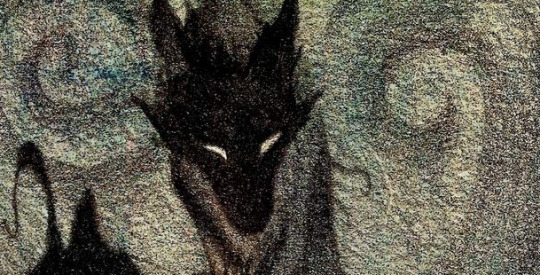
Not necessarily my favorite of the bunch, but one who sort of epitomizes what you asked, a character who is both incredibly obscure and incredibly underrated in every sense. Despite the book being somewhat known, mainly thanks to the movie, the character is so obscure that I don’t even have an illustration of her to display here, not even fan art, just one of the book’s covers that I think best conveys it. Luckily, the book is also available freely online, so you can all go check it out here. The movie adaptation does not feature the character of Luna Bartendale which makes it pointless to talk about.
To not spoil it too much, The Undying Monster is a very fascinating book, ahead of it’s time in quite a few ways. You expect it to just be a detective story centered around a werewolf cursed, except the subtitle of the book is “The Fifth Dimension” and then it goes to talk about dimensions of thought and post-WWI trauma and love and hypnotic regression that travels through time and ancient runes and Norse mythology. It’s not exactly an easy book to get through in one setting, but I’d recommend it much the same if only because it’s got supersensitive psychic sleuth Luna Bartendale, literature’s first female occult detective, and she’s an incredible character who absolutely feels like she should have become a literary icon.
She lives in London but is world-renowned for her many good deeds. She is a small, pretty woman, with curly blonde hair, dark eyebrows and a high-bridged nose, and a slight build. She has a voice described as a light soprano that "does not make much noise but carries a long way".
Petite, bedimpled and golden curled, Luna is completely in charge of events, dominating every scene that she appears in with her welcoming disposition and cleverness.
Bartendale has various psychic powers, including mind reading. She is well-versed in psychic and occult lore, is a “supersensitive” psychic, and has a “Sixth Sense” which allows her to trace things and people through both the Fourth and the Fifth Dimension. (The Fifth Dimension is “the Dimension that surrounds and pervades the Fourth–known as the Supernatural”).
Her extensive knowledge of occult rites and practices puts John Silence, Carnacki and Miles Pennoyer to shame, and she beats them all with her "super-sensitive" gift of being able to psychically connect with troubled souls and hypnotize them.
She uses a divining rod for various tasks, including psychic detection and tracking, and distinguishing between benevolent and malevolent forces. She has various (undefined) powerful psychic defenses, can carry on seances, and can even cure a person of “wehrwolfism.” And she can always rely on her massive, intelligent dog Roska for help.
Luna sadly doesn’t show up in the book as often as I’d hoped, but everything about this character is so delightful. In a lot od ways she hardly feels like a pulp hero, at least the ones I usually talk about. She feels like a lost protagonist from an incredibly successful kid’s adventure series where a kind and eccentric detective witch and her giant dog go around solving occult mysteries and encountering all sorts of weird supernatural beings while counseling and helping people, like Ms Frizzle meets Hilda. Like this character is just waiting for Cartoon Saloon to make a film about her.
Its not so much “this character should/could be popular but it’s clear why that didn’t pan out”, it’s more me being confused as “why the hell isn’t she super popular? This character should have had a franchise ages ago, holy shit put her in everything””
42 notes
·
View notes
Note
Why did it take so long for Carol Danvers to become Captain Marvel, in your opinion? It feels like it should have happened like 10 years before it actually did?
Prepare for a weird story of comic book law!
So back in 1939, the character known now as Shazam first appeared under the name Captain Marvel. He was a huge success, because he was basically Superman but if Superman’s secret identity was a young boy just like comic book readers. He was so much like Superman that DC sued Captain Marvel’s publisher (Fawcett Comics) for copyright violation, and a twelve year lawsuit ensued. While Fawcett technically won the case, the end of the Golden Age boom and their skyrocketing legal expenses forced a settlement, and Fawcett went out of business.
So from the early 50s onwards, no one owned the name Captain Marvel. An indie comic book company put out a short-lived comic featuring an entirely different character called Captain Marvel. Martin Goodman, the publisher of Marvel Comics, didn’t like some other company using his company’s name for their superhero, so he offered the indie company $6,000 for the right to the character. The indie company refused, so Goodman decided to play hardball: he ordered Stan Lee and Gene Colan to invent a new superhero who would be named Captain Marvel (a Kree super-soldier named Mar-Vell).

The indie company sued Marvel for trademark infringement, and Marvel retaliated by counter-suing arguing that it owned the trademark for the name Marvel as applied to superhero comics. The indie company folded, taking $4,500 and agreeing to stop publishing its Captain Marvel book. Marvel then promptly took out a new trademark for the name Captain Marvel.
No one liked Captain Marvel. The fans didn’t like him (his books tended to sell rather poorly), Stan Lee and Gene Colan famously didn’t like him, but they had to keep using Captain Marvel lest the trademark lapse, which Marvel wasn’t about to do...because D.C had bought the rights to the original Captain Marvel and Marvel had greatly enjoyed getting to send a cease and desist letter to D.C which has ever since forced them to refer to the original Captain Marvel as Shazam.

Finally, by the early 80s, Marvel decided to kill off Mar-Vell (in their very first graphic novel, no less) and replace him with a new Captain Marvel: Monica Rambeau. The very first African-American woman to be an Avenger, Monica was Captain Marvel from 1982 to the mid-90s, when she changed her superhero name to Photon (later to Pulsar, and then Spectrum) and was replaced as Captain Marvel by a bunch of minor characters who never lasted very long, and then in 2012 Carol Danvers became the current Captain Marvel.
So who was Carol Danvers? Originally, she was a supporting character of Mar-Vell’s, an Air Force security officer who becomes Mar-Vell’s human liason. Then in 1977, Carol Danvers became a superhero named Ms. Marvel. This name was chosen for two reasons: first was that the success of the Bionic Woman tv show as a spinoff of the Six Million Dollar Man had scared Marvel that they didn’t own the rights to female versions of its superheroes. In order to prevent anyone creating distaff ripoffs of its most commercially well-known characters, Marvel created She-Hulk (because they had an Incredible Hulk tv show), Spider-Woman (because of the Spider-Man cartoons), and (among others) Ms. Marvel. The second reason was that the honorific Ms. was very much associated with second-wave feminism thanks to Gloria Steinem’s Ms. magazine, and 70s Marvel was down to chase any trend, so Carol Danvers switched careers from the U.S Air Force to become the editor of Women Magazine, a feminist subsidiary of the Daily Bugle.

Ms. Marvel was one of the first gigs of a young Chris Claremont, and he loved Carol so much that he took her with him to the X-Men when he felt that the Avengers writers had badly mishandled her character. She then spent a lot of the 80s as an X-Men adjacent character under the names Binary and Warbird, having acquired new superpowers after Rogue had stolen her original superpowers.
After Claremont left Marvel in the early 90s, Carol Danvers eventually reverted back to Ms. Marvel and being an Avengers-based character. By 2005, Marvel made its first trial run at changing the name to Captain Marvel in Brian Michael Bendis’ House of M, but it took a further seven years for the change to stick, mostly because the name Captain Marvel was viewed as something of an albatross (see all the unsuccessful Captains Marvel between Monica and Carol) whereas Ms. Marvel was thought to have some cachet even after the original second-wave connotation.
46 notes
·
View notes
Video
tumblr
Dick Grayson timeline
Also known as the list I started trying to get the pictures in my 80-year anniversary video in the right order. I have skipped a lot of video games, and a number of Elseworld comics and I have not included for instance every Teen Titans/Titans title Dick has ever been in. And, of course, it does not include every story arc, retelling of Dick’s history or single issue he’s been in. (This video and timeline are reposted for technical reasons...)
1940. Dick Grayson / Robin debuts in Detective Comics # 38. (April issue, but it was released earlier. I have seen both March 5 and 6 named as release date and I’ve also read that this is an approximation. Evidently, the delivery date varied greatly back in the days.)
1943. Movie serial The Batman with Douglas Croft as Robin.
1943. October 25. Publication start of the daily comic strip Batman and Robin. Ends in 1946.
1945. (March.) Batman and Robin’s first appearance in the radio show The Adventures of Superman, with Ronald Liss as Robin.
1947. (February.) The first Robin solo series starts in Star Spangled Comics # 65. Robin - The Boy Wonder (sometimes with the addition of Batman) would continue in SSC until the title ended in July 1952, # 130.
1949. Movie serial The New Adventures of Batman and Robin, with Johnny Duncan as Robin.
1950. Robin’s first outing as Batman (with a Robin symbol instead of a Bat) in DC # 165.
1952. Superman # 76. The first time Batman and Superman meet in comics (it ends with Robin taking Lois Lane to dinner.)
1954. Batman, Robin and Superman team up for the first time in World’s Finest Comics # 71.
1964. First appearance of what would become the Teen Titans, in The Brave and the Bold #54.
1966. Batman: The Movie and the tv show. Burt Ward as Robin.
1966. May 29. Publication start of the daily comic strip Batman with Robin the Boy Wonder. It ends in 1969.
1966. A manga adaptation of Batman is published in Japan, with Jiro Kuwata as main artist. The manga is published 1966-1967 and adapts Silver age Batman stories.
1966. Teen Titans vol 1.
1967. First appearance of Robin of Earth-Two, in Justice League of America #55. (He was considered to be the Dick Grayson from the ”Golden age” stories. As an adult, he was a member of the Justice Society of America, a lawyer, ambassador, and attorney. He went out as Batman once in his career.)
1969. (December.) Dick moves from Gotham to Hudson university in ”One bullet too many!”, Batman # 217. Bruce and Alfred leaves Wayne Manor. Robin will have sporadic solo stories in the Bat titles until the early 1980s.
1972. Batman and Robin in The New Scooby-Doo movies with Casey Kasem voicing Robin.
1973. The Super Friends, animated television series with Batman and Robin and other superheroes. Produced by Hanna-Barbera. Casey Kasem is voice actor for Robin.
1976 (to 1981). The comic book Super Friends adapted the adventures from the television animated series.
1977. The New Adventures of Batman, animated, with Burt Ward as Robin.
1978. Teen Titans vol 1 ends.
1980. (October.) Dick leaves Hudson university, resigned to the fact that he can’t continue as Robin and keep up with college. In ”The Gotham Connection”, in Detective Comics #495.
1980. The New Teen Titans. (# 1 in November.)
1980. (December.) Dick comes to Gotham in Batman # 330. Bruce is disappointed he has left college.
1982. Bruce, Alfred and Dick moves back to Wayne Manor and the Batcave, in Batman # 348.
1984. Dick decides to stop calling himself Robin in Tales of the Teen Titans # 39 (February).
1984. Dick gives Jason Todd his old Robin suit in Batman # 368 (February).
1984. Dick becomes Nightwing in Tales of the Teen Titans #44 (July).
1985-1986. Crisis on Infinite Earths. Earth-Two is erased from continuity. However, that world’s Dick Grayson (still using the name Robin) and Helena Wayne (Huntress), did not perish with their world since they were in the battle against the Anti-Monitor. They were killed and buried at Valhalla Cemetery on the remaining Earth.
1987. The Crisis catch up with Batman with a new version of how Dick left Robin, and a new origin story for Jason Todd, in Batman # 408 (June).
1989. Batman Year Three. Storyline in Batman # 436-439.
1989. In the story arc A Lonely place of Dying, Dick becomes the new co-owner of Haly circus and low-key supports Tim Drake as a new Robin.
1990. The Batman Murders, a novel written by Craig Shaw Gardner with Dick/Nightwing as a prominent character. It takes place in a timeline similar to the comics at the time, after Jason’s death but before Tim.
1992. There were plans for writer/artist Art Thibert to write a miniseries together with Pamela Winesette that would start around New Titans # 93 and end with Dick and Starfire getting married (in New Titans # 100). An editorial shift in DC resulted in the plans being scrapped.
1992. Batman The Animated Series. Loren Lester as Robin.
1992. The Batman Adventures. Tie-in comic to BTAS. Ends in 1995.
1994. KnightsEnd Prodigal. Dick’s first longer stint as Batman, with Tim as Robin.
1995. TAS game.
1995. Nightwing Alfred’s return.
1995. Batman & Robin Adventures, tie-in to BTAS. Ends in 1997.
1995. Batman Forever, with Chris O’Donnell as Dick.
1995. Nightwing vol 1, a 4 issue mini series.
1996. Dick Grayson is Moonwing, agent of S.H.I.E.L.D. in Bruce Wayne, Agent of S.H.I.E.L.D. Moonwing is an amalgamation of Marvel’s Moon Knight and DC’s Nightwing in the Amalgam Universe.
1996. Shadow of the Bat Annual # 4, a medieval fantasy AU where Bruce is the king hiding in his castle while Dick fights in his place as Batman (and is killed).
1996. Nightwing vol 2. Dick moves to Blüdhaven in # 1.
1996. Kingdom Come. Dick is Red Robin and has a daughter, Mar’i, with Starfire.
1997. Batman & Robin. Chris O’Donnell as Dick.
1997. Batman and Captain America. (Earth-3839)
1997. Nightwing Annual # 1. Dick pretends to marry a woman to investigate if she has murdered previous husbands.
1997. The Batman Chronicles: The Gauntlet.
1997. Thrillkiller. Elseworld story.
1998. Batman & Mr Freeze: SubZero. Loren Lester as the voice of Dick/Robin.
1998. The Batman Adventures. The Lost Years. 5 issue mini-series, BTAS Dick leaves Gotham, at odds with Batman, and Robin. He travels the world to learn. When he finally returns, he has transformed to Nightwing.
1998. Batman: Gotham Adventures. Continuing BTAS comic, with Dick as Nightwing and Tim as Robin. Ends in 2003.
1998-1999. Batman: Dark Knight of the round table. Elseworld story.
1999. Dick joins the Blüdhaven Police Academy in Nightwing # 32, planning to fight the corruption from the inside.
1999. Dark Victory.
1999. The Kingdom. Sequel/prequel to Kingdom Come.
1999 (-2004). Superman and Batman: Generations. (Earth-3839 again)
2000. Dick gets a job as a cop in Blüdhaven, in Nightwing # 48.
2001. Dick is Batman (and is killed ) in Superman and Batman: Generations # 2.
2001. Robin Year One.
2001. Dick is adopted in the main continuity, in Batman: Gotham Knights # 21.
2001. JLA: Riddle of the Beast. Elsworld story (a fantasy story where Batman keeps Nightwing’s dead body sitting beside him on the throne).
2001–2002. Batman: The Dark Knight Strikes Again, by Frank Miller and more. Dick Grayson, who used to be Robin but was abused and sacked by Batman, has become a Joker-like character, an insane criminal with a healing factor and shape-shifting abilities. In the end, he is killed by Batman.
2002. Batman: Nine lives. Elseworld story. (Set in Gotham in the 1940s, Dick Grayson is a private detective.)
2002. Nightwing becomes the leader of a new line-up of the JLA in the storyline The Obsidian Age (JLA # 69). The former members have disappeared but Batman had a contingency plan: a new team lead by Nightwing.
2003. Teen Titans (tv). Scott Menville as Robin.
2003. Donna Troy is (seemingly) killed in Titans/Young Justice: Graduation day. Nightwing declares that ”The Titans are finished”.
2003. Dick becomes leader of the Outsiders in Outsiders vol 3 # 1. He’s been persuaded by Roy Harper/Arsenal, who claims this team will not be a family, only co-workers.
2003. Dick is fired from the police force in Nightwing # 83, when Police Captain Amy Rohrbach, Dick’s former partner, realizes he is Nightwing.
2003. Batman Adventures vol 2. New tie-in comic to BTAS, where Dick/Nightwing makes the occasional appearance. Ends in 2004.
2004. DC: The New Frontier by Darwyn Cooke.
2004. The Batman Strikes. Tie-in comics to the animated tv show The Batman, where Dick will turn up in 2006 (and in # 29, 2007). Ends in 2008.
2005. First issue of Frank Miller’s All Star Batman & Robin, the Boy Wonder.
2005. Year One: Batman/Scarecrow.
2005. Nightwing Year One. Storyline in Nightwing # 101-106.
2006. Infinite Crisis. Blüdhaven is destroyed by a gang of supervillains who drop the radioactive Chemo over the city, as vengeance against Nightwing. There were plans to kill Dick in Infinite Crisis, but DC changed their minds and he was badly hurt instead.
2006. Nightwing starts operating in New York in Nightwing # 118.
2006. Batman/The Spirit.
2006. "Inheritance", a novel by former Nightwing and Batman-writer Devin Grayson. It revolves around three superheroes and their former sidekicks – Batman and Nightwing, Green Arrow and Arsenal and Aquaman and Tempest. (I haven’t read this myself, but from what I’ve seen her take on Dick – and Bruce’s and Dick’s relationship – is pretty controversial among fans.)
2006. Dick makes his debut in the animated The Batman (2004). Robin is voiced by Evan Sabara. In the episode ”Artifacts”, an older Dick as Nightwing is voiced by Jerry O’Connell.
2007. Dick steps down as leader of the Outsiders. Batman takes over and tells him ”Go back to the good fight, Dick. Leave the bad fight to us.”
2008. Tiny Titans.
2008. Justice League: The New Frontier. Animated movie adaptation of Darwyn Cooke’s limited series.
2008. Dick becomes curator of The Cloisters in New York, in Nightwing # 141.
2008. Dick Grayson of Earth-43. (Countdown Presents: The Search for Ray Palmer: Red Rain # 1.)
2009. NightLantern/Hal Grayson, an amalgam of Dick and Hal Jordan in a dream world created by Doctor Destiny. Superman/Batman # 60-61.
2009. Nightwing vol 2 ends. Dick moves back to Gotham after Bruce’s ”death”.
2009. Batman: Battle for the Cowl. 3 issues. Jason wants to take over as a more violent Batman, he shoots Damian and leaves Tim for dead before Dick, who is reluctant to put on the cowl, defeats him.
2009. Batman: The Widening Gyre. 6 issue series that was supposed to have a continuation. Dick is Robin (and younger Nightwing) in flashbacks and Nightwing in the present. An elseworld where Bruce is set to marry Silver StCloud, but the flashbacks borrow a lot from canon stories.
2009. Li’l Gotham.
2009. Dick makes his debut as Batman in Batman #687.
2009. Batman & Robin vol 1, with Dick as Batman and Damian as Robin.
2009. Dick/Robin appears in the episode ”The Color of Revenge” of Batman: The Brave and the Bold. Dick is voiced by Crawford Wilson.
2010. Young Justice (tv). Robin is voiced by Jesse McCartney.
2010. Batman: Under the Red Hood. Dick/Nightwing is voiced by Neil Patrick Harris.
2010. Dick appears in the episode ”Sidekicks Assemble” of Batman: The Brave and the Bold. Young Robin is voiced by Jeremy Shada, older Robin/Nightwing by Crawford Wilson.
2010. Dick appears in Batman Beyond (with an eye patch), vol 3, Hush Beyond. This Hush turns out to be a clone of Dick, made by Amanda Waller to have someone to replace Bruce as Batman if needed.
2011. Flashpoint.
2011. Flashpoint: Deadman and the Flying Graysons. A mini-series with an alternate university where Dick ends up as the new Doctor Fate.
2011. Nightwing vol. 3. (New 52) When the series start, Dick has moved to his own place in Gotham after having filled in as Batman for ”almost a year”. (Before Flashpoint, he was Batman for more than a year.)
2011. In Batman Beyond vol 4, Dick has a small part in issue 4. There he goes public with that he was Nightwing and claims he was a paid employee and never saw Batman without a mask. (He is not on speaking terms with Bruce.)
2011. Batman Live, stage show with Kamran Darabi-Ford and Michael Pickering as Dick.
2011. Batman: Arkham City. Dick/Nightwing makes no-speaking appearance in the game.
2011. The Court of Owls, storyline i Batman vol 2 about a secret organization that will later be revealed to have ties to Dick’s family.
2012. Young Justice season 2, Dick has become Nightwing, voiced by Jesse McCartney.
2012. Holy Musical B@man. (March 22-25, at Hoover-Leppen Theatre in Chicago, Illinois.) Nick Lang as Robin.
2012. ”The Gray Son” in Nightwing vol 3 # 9. The Grayson family gets a new origin story with the Court of Owls.
2013. Batman Beyond 2.0, where Dick works with Terry McGinnis/Batman.
2013. Dick moves to Chicago in Nightwing vol 3 # 19, following the trail of Tony Zucco, the man who killed his parents.
2013. Batman ’66, comic book continuation of the tv show from 1966.
2013. Arkham Origins (game). Josh Keaton is voice actor for Dick/Robin.
2013. Injustice: Gods Among Us, a video game, Troy Baker as voice actor.
2013. Nightwing is killed in the game tie-in comic Injustice: Gods Among Us #16.
2013. Teen Titans Go. Scott Menville is voice actor for Robin.
2014. In Batman Beyond 2.0 # 17-24, we get a glimpse of an alternate Dick, in the Justice Lord’s timeline, married to Barbara and where they have a son, John.
2014. Nightwing vol 3 ends.
2014. Forever Evil, where Lex Luthor kills Dick to stop a bomb, wired to his heart, to explode. But revives him (possibly only because Batman attacks him).
2014. Grayson. Batman has (pretty much forced) Dick to pretend to remain dead and infiltrate the organisation Spyral.
2014. Son of Batman (DC AMU). Sean Maher is the voice of Dick/Nightwing.
2014. Earth 2: World’s end. On this earth, Dick and Barbara are married and have a son, John. The world is destroyed and Barbara is killed. Dick, who was a reporter, lets John go so the boy can be saved on a spaceship but Dick eventually ends up with Batman, Thomas Wayne, and gets away from the doomed planet.
2014. Nightwing: The Series, a fan-made live action webb-series produced by Ismahawk, with Danny Shepherd as Dick/Nightwing.
2015. Titans Hunt.
2015. Batman vs. Robin (DC AMU). Sean Maher is the voice of Dick/Nightwing.
2015. Arkham Knight (game). Scott Porter is the voice actor for Dick/Nightwing.
2015. Batman: Arkham Knight. Limited series, a prequel to the game. Dick makes a blink-and-you-miss-it appearance.
2015. Batman & Robin Eternal.
2015. Batman Unlimited, a series of direct-to-video animated films (Animal Instincts (May 2015), Monster Mayhem (August 2015) and Mechs vs. Mutants (September 2016) ) and online-shorts inspired by the action figure line produced by Mattel. Dick is Nightwing.
2015. Convergence. DC event featuring characters from earlier continuities. It consist of a main miniseries as well as a number of 2 issue miniseries. In the main story, Dick from Earth 2 teams up with Batman/Thomas Wayne. When they visit the Batcave of pre-Flashpoint Batman Alfred offers Dick a cup of Earl Grey. After Thomas Wayne hs been killed, Dick decides to continue in his footsteps. This story continues in Earth 2: Society.
2015. Convergence: Nightwing/Oracle. 2 Pre-Flashpoint characters, the story ends with Dick and Barbara marrying.
2015. Convergence: The New Teen Titans. NTT from the time of Crisis on Infinite Earths. Dick is married to Koriand’r/Starfire.
2015. Convergence: Detective Comics. Dick Grayson/Robin and Helena Wayne/Huntress of the old Earth-Two are forced to fight Superman Red Son. The story ends with Dick putting on Batman’s suit. (This Dick and Helena were earlier killed in Crisis on Infinite Earths #12 in 1986.)
2015. Dick is the Batman in Earth 2: Society, a continuation of Earth 2: World’s End.
2016. Batman: Bad Blood (DC AMU) Dick/Nightwing is voiced by Sean Maher.
2016. Batman Beyond 2.0 ends. Dick and Bruce seem to reconcile.
2016. Grayson ends.
2016. Nightwing vol 4 (Rebirth).
2016. Return of the Caped Crusaders. Burt Ward as the voice of Dick/Robin.
2016. Superman American Alien # 4, where a young Dick makes an appearance.
2016. Dick moves to Blüdhaven in (Rebirth) Nightwing # 10.
2016. Batman /TMNT Adventures.
2016. Titans (Rebirth comics, discontinued 2019).
2017. Teen Titans: The Judas Contract (DC AMU). Dick/Nightwing is voiced by Sean Maher.
2017. The Lego Batman movie. Michael Cera is the voice of Dick/Robin.
2017. Batman/Teenage Mutant Ninja Turtles II.
2017. Batman: White Knight.
2017. Batman vs. Two-Face. Burt Ward is the voice of Dick/Robin.
2017. Batman and Harley Quinn. Loren Lester is the voice of Dick/Nightwing.
2017. Batman and Harley Quinn. 7 issue comic.
2017. Nightwing: The New Order. Dick and Starfire have a son, Jake, in a future where Dick as Nightwing had used a device to nullify superpowers, believing it was the best way to save humanity.
2018. Teen Titans Go. To the Movies. Scott Menville is Dick/Robin.
2018. Dick appears in Batman Beyond (2016) vol 6 # 25. This is another version than in earlier Batman Beyond, he has both his eyes, a beard and a daughter, Elainna. Dick is the mayor of Blüdhaven.
2018. Batman # 55 (September). Dick is shot in the head and the amnesiac Ric storyline begins. He supposedly tries to build a new life in Blüdhaven, away from the Wayne’s and superheroing, while the name Nightwing is used by three cops and a firefighter; however, Dick is soon out fighting crime again.
2018. Titans (tv). Brenton Thwaites is Dick Grayson/Robin.
2018. Batman Ninja. Daisuke Ono is the voice actor for Nightwing.
2018. Batman/Teenage Mutant Ninja Turtles II.
2018. Batman: Gotham by Gaslight. Lincoln Melcher is the voice actor for Dickie.
2019. Young Justice: Outsiders. Dick/Nightwing is voiced by Jesse McCartney.
2019. Richard "Dick" Grayson / Robin, the leader of the Tween Titans and adopted son of Bruce Wayne in the animated show DC Super Hero Girls. Debuted in From Bat to Worse (July, 2019) Voice actor Keith Ferguson.
2019. Batman: Hush. (DC AMU). Sean Maher is the voice actor for Dick.
2019. Batman: Last Knight on Earth (where Dick for a time goes by Talon, because the bats were defeated, and he and Barbara have a daughter, Bryce).
2019. DCeased, where Dick is one of the first to succumb to the virus.
2019. Batman: Curse of the White Knight.
2019. Lego DC Batman: Family matters. Will Friedle is the voice actor for Dick/Nightwing.
2019. Tales from the Dark Multiverse. Teen Titans The Judas Contract. Dick and all the other Titans, heroes and most of humanity (I think) are killed by Terra.
2019. Teen Titans Go! vs Teen Titans. Scott Menville is the voice of both Robins.
2019. Nightwing has a small part in the novel “The Court of Owls” by Greg Cox (Titan book).
2019. The Court of Owls have given Dick false memories after he was shot in the head, and he is dressed up as a Talon for a while in the Nightwing comic.
2019. Batman/Teenage Mutant Ninja Turtles III.
2019. Batman: Curse of the White Knight. Sequel to Batman: White Knight
2019. Dick (Brenton Thwaites) becomes Nightwing in the last episode of season 2 of Titans.
2020. In the regular Nightwing title, Dick starts to regain his true memories. However, when this is being written, Coronavirus and DC events make it unsure when we’ll get the real Dick back.
2020, March 18. Robin 80th Anniversary special.
2020. Batman: The Adventures Continue. (The continued adventures of BTAS in comic books.)
2020: Dick appears in Titans: Titans Together, as well as Batman: Gotham Nights. Digital comics that seem to take place outside the main continuity.
2020. Justice League Dark: Apokolips War (DC AMU). (Nightwing is killed, Damian tries to revive him in a Lazarus pit but his mind never heals.)
2020. Dick regains his memories in Nightwing vol 4 # 74 (September 8), 720 days after he lost them in Batman vol 3 # 55. He gets back into his Nightwing suit in Batman vol 3 # 99.
2021. In the DC possible future-event Future State (January-February 2021), Dick is in two books: Nightwing and Teen Titans.
2021. Dick gets himself a thre-legged puppy in Nightwing vol 4 # 78. Fans in the USA could vote and she got the name Haley (alias Bitewing).
2021. After the relaunch Infinite Frontier, parts of Dick’s pre-Flashpoint history in Blüdhaven has been restored. He has for instance been a cop, and lives in the apartment building he bought during Nightwing vol 2.
2021. In the title Teen Titans Academy, which seems to be a prequel to Future State: Teen Titans, Dick is one of the mentors for a new generation of Titans. Dick also makes appearances in for instance Future State: Gotham, The Batman & Scooby-Doo Mysteries and has a story in Batman: Black & White (2020) # 5.
2021. Dick is Police Commissioner of Gotham in Batman/Catwoman, a 12 issue Black Label miniseries written by Tom King.
2021. Season 3 of Titans.
2021. Dick is an adorable Robin from an alternate universe in Batman/Robin (2019) # 16–21 plus Annual # 1, written by Gene Luen Yang.
2021, September. Batman: Wayne Family Adventures, comic at Webtoon. A fanon-friendly take where Wayne Manor is filled to the brim with (more or less) adopted junior vigilantes.
2021. Injustice: Gods Among Us animated movie, Dick is in there to die and become the new Deadman, I guess. Voice actor Derek Phillips.
2021. Yoshi Sudarso was supposed to be Nightwing/Dick Grayson in a live-action mini-series adaptation of the fanon-friendly webtoon Batman: Wayne Family Adventures by Ismahawk. But after the news broke, it seemed to be stuck in limbo.
2021. Young Justice: Phantoms. Season 4 of the animated show on HBO Max in October.
2021, November. Robin and Batman, a three issue miniseries written about Dick’s first time as Robin. Writer Jeff Lemire, art Dustin Nguyen.
2021. Batman vs Bigby! A Wolf in Gotham. A Batman/Fables crossover limited series where (as far as I understand) everyone stays as a Robin, including Dick.
2021. DC vs Vampires. A 12 issue limited series. In #6 (2022), Nightwing is showed to be the Vampire king and kills several of his family on panel.
2021, September. Batman: The Audio Adventures. Melissa Villase˜njor is voice actor for Robin.
2021, November. Robins, six issue miniseries written by Tim Seeley, the winner of DC’s Round Robin contest.
2021, November. Dark Knights of Steel, Fantasy AU written by Tom Taylor, art by Yasmine Putri. Nightwing/Dick is one of “Batman’s” Robins in this the world.
2021. Nightwing is annoounced as a playable character in the Gotham Knights game, together with Red Hood, Robin (Tim) and Batgirl (Barbara). Voice actor Christopher Sean. The game was published in 2022.
2022. Dick is Robin in Batman/Superman: World’s Finest, stories from the past that are tied to the current continuity via Batman vs. Robin and Lazarus Planet.
2022. Batman: Beyond the White Knight. Sequel to Batman: White Knight and Curse of the White Knight. It is revealed (unless it was in an earlier book) that Jason Todd was the first Robin and Dick was the second.
2022. In the comic book Future State Gotham, Dick used the enhancing drug Brane to gain an edge in the fight against the Magistrate and assorted villains. It enhanced his intelligence and gave him some precognition. He also started to use a Batman-like suit. In the end (#18), Dick sacrifices himself to destroy the ghost of Joe Chill, who had possessed Damian. (🤷♀️ Yeah, I know, I wouldn’t pay to read that...)
2022. Dark Crisis on Infinite Earths # 1-7. The Justice League is presumed dead (Nightwing seems to be sure they will come back) and super criminals attack en masse. Along the way, “the Great Darkness” tries to take Nightwing as its new host but he fights it off. At the end of the event, the Justice League disband.
2022. Nightwing is a character in the third season of the animated Harley Quinn on HBO Max, with Harvey Guillen as voice actor.
2022. Batman: Gotham Knights – Gilded city. A tie-in prequel to the video game Gotham Knights.
2022. Titans United: Bloodpact. Limited series, set in its own universe as far as I can see.
2023. Batman: Justice Buster. A 32 chapter manga by Eiichi Shimizu and Tomohiro Shimoguchi (started publishing in English 2023).
2023. Batman: The Doom that came to Gotham. Animated movie adaptation of Elseworld comic book from 2000, that takes place in the 1920s. Jason Marsden is voice actor for Dick Grayson.
2023. World’s Finest: Teen Titans. A spin-off from Batman/Superman: World’s Finest.
2023. Titans, a new comic book about the Titan’s residing in Blüdhaven and functioning as the prime superhero team.
2024. Nightwing and his bike Nightbike makes in appearance in the animated tv show Batwheels (2.1), voiced by Zachary Gordon.
2024. Batman: Dark Ages. Alternative universe limited series. Over the course of the series, we see Dick as Robin and Nightwing and eventually dying, still quite young.
2024. Boy Wonder. A limited series about Damian and his Robin-brothers, Dick is Nightwing.
2024. Batman: Caped Crusader, episode Nocturne. Four kids with Robin-names are seen in the orphanage in the animated tv show. Dickie, voiced by Carter Rockwood, Jace, Stephanie and Carrie.
2024. DC Vault – Death in the Family – Robin Lives. In the end, Jason becomes the Joker and Dick Batman.
2024. Batman The Long Halloween: The Last Halloween. A continuation of Dark Victory, with Dick as Robin.
154 notes
·
View notes
Text

No, that's not a colorist's mistake. This is the first appearance of the Golden Age character The Blue Flame, from Captain Flight #11 (February, 1947).
Not only did this guy look identical to (except for the color) and have the same powers as Timely's the Human Torch, when he dropped his flame his costume was the same as the Torch's sidekick, Toro.

The similarities are so close it's a wonder Timely (the company that eventually became Marvel Comics) didn't sue. Maybe, they didn't think it was worth firing up (pun intended) their lawyers.
That's because the Blue Flame only had this one appearance, and Captain Flight was canceled right after this issue was released. Heck, the comic business was in such a tailspin after World War ll that the publisher, Farrell Publications, was out of business the next year (don't worry; they got better a few years later).
As for the Blue Flame himself, other than his powers and appearance, he's pretty much a mystery. His identity, secret or otherwise, is never revealed, and there is no explanation of how he gained his powers. Heck, we don't even know if he's a really a human, or an android like the Human Torch. I guess that since he was just a one-shot wonder it doesn't really matter.
4 notes
·
View notes
Text
FanFiction.net MASTERLIST
Here are the FanFiction I’ve read on FanFiction.net. Hope you’ll enjoy!
For each recommendation I’ve linked the story to the title and wrote/copied a little summary. Please remember that many stories are rated M or E, if not stronger. Read on your own risk!
justhugefangirl’s masterlist
fanfiction recommendation masterlist
Love’s Labour Found by Peanutbuttertoast1
The War may be over, but Hermione Granger's life is just starting as her true heritage is revealed. Being the Heir to the Throne of England and a real life Princess is just the beginning of Hermione's story...but how will the Wizarding World react when they learn the Golden Girl and Gryffindor Princess is really a real life Royal?
This fanfic os one of my favourites, read it already three times- I can’t. It’s perfect, okay? For me it’s perfect.
---
A Witch in Gotham by Peanutbuttertoast1
After the Second Wizarding War, a curse rips through the Magical World, leaving devastation in its wake. Hermione Granger is tasked to find the reason, and the cure before more lives are lost. Retreating into the Muggle World to start over, Hermione finds her way to Gotham City as Mia Black, Head of the Black Foundation. Her decision to help the Batman changes her life forever.
A perfect crossover- honestly, this author is perfect. As well this story. I don’t link more of the authors work but there are some other ones which are just ... perfect.
---
Mischief Managed by fringeperson
A man with black hair, green eyes and pale skin watched over a child with black hair, green eyes, pale skin, and a variant of the Elder Futhark rune Sowilo etched upon his brow.
Mischief Mastered (part of story)
---
Green Eyes and Red Hair by fringeperson
He was a practical joker with messy black hair. She was a talented woman with bright red hair. It turned out that they both had green eyes. Their daughter, when she came, was untouchable for more reasons than one. Loki-is-James, Natasha-is-Lily, Rogue-is-Fem!Harry.
I love the relationship between Loki and Natasha :)
---
Love on Her Arm by Eye Greater Than Three
During a trip to Gringotts, Hyacinthe Potter discovered she met her soulmate, William Weasley. Bill/Hyacinthe. female!Harry.
---
The Winter Witch by Kneazle
Hermione realized it began with a sense of Impending Doom and finished with a battle outside her tent. The deciding line between staying and helping Robb Stark, or returning to her universe, is getting harder to see the longer she's in Westeros. But it's a decision that she has to make, or it's one that will be made for her. Part 1 & Part 2 complete! Part 3 now ongoing.
This... is one of my favourites crossovers,,, the slowburn between Hermione and Robb,,, and it’s so fluff,,, I’m such a sucker for dark stories but this is just pureness and ugh-
---
Moratorium by Darkpetal16
Harry Potter could never be the hero. But, she might make a great villain. Satire. Parody. -COMPLETE- F!Harry Fem!Harry Gray!Harry.
Uhm- this is one of the darker fics I love. It’s very good written, cause of this I really don’t mind the ship fem!Harry x Tom Riddle
---
A Life Twice Lifed by Nemesis13
Draco Malfoy died at the venerable age of 107, and who awaited him at the crossroads? His mother? His wife? No, it had to be his eccentric former rival, eventual best friend, and far too often partner in chaos Harry Potter. Oh, and of course he had a deal to offer Draco to live his life anew, and obviously there was a caveat to it all that he wasn't privy to, damn Potters.Fem!Draco
Ahh, Drarry. How I love this ship
---
Persephone by dulce.de.leche.go
Better to be the right hand of the devil than in his path. Better still to be the consort of Hades than a part of his collection of souls. Ten years after Voldemort has won the war, Hermione reaches a breaking point and shreds the flow of time to change her future. If she can't change the world, she will change her place in it. Extremely dark Tomione/Volmione. Warnings inside.
As already written in the summary, this fic is hella dark. So if you don’t like dark fics (especially with all the warnings mentioned in the first chapters) don’t read. I still love it tho-
---
The Muddy Princess by Colubrina
Just another Pureblood!Hermione story. A hidden adoption revealed, a brother found, a new world to figure out: "What are you hoping for?" he asked as they stood ready to do the spell. "I don't know," Hermione admitted. "You?" His knuckles were white on his wand. "A sister," he said, his voice very low, "I'm hoping for a sister."
There are more stories from this author which are just- awesome and absolutly perfect, like the next ones. Since they have over 60, I won’t link every work here.
---
Lady of the Lake by Colubrina
Hermione and Draco team up after the war to overthrow the Order and take over wizarding Britain. They have plans and they'll get power, but the cost of victory may be higher than they expected and more than they can bear. Dark Dramione. COMPLETE
This is perfection. Nothing more to say.
---
Dark Cherry Chapstick by Colubrina
Hermione returns for an optional 8th year after the war and Draco Malfoy, also back at Hogwarts at his mother's request, notices she's changed. A brief dip into the 'makeover' trope AND the 'goth' trope in one fic. ONE SHOT. Dramione.
---
The Green Girl by Colubrina
Hermione is sorted into Slytherin; how will things play out differently when the brains of the Golden Trio has different friends? AU. Darkish Dramione. COMPLETE
---
The Last Peverell by animerocker 646
Being the Master of Death made life difficult, especially when you need to save all of magical Europe from inbreeding its way to extinction. At least Death was enjoying watching his Master attempt this over and over again. Harry didn't find it nearly as entertaining. Well, tenth times the charm right? (FemHarry)
---
Soft, Low, English Accent by Tsume Yuki
'God, you've got a beautiful voice.' Hariel always found it funny, that of all the things her soulmate could take note of -the messy hair, the bright green eyes, the scar- it's her voice he points out first. FemHarryxMatt
---
Bless the Broken Road by Tempestas D. Uzu
Her resolve crumbled in the face of Pietro Maximoff's scruffy good looks and warm blue eyes, and she found herself falling for another person who would be doomed to die for her selfishness. (One Shot)(fem!HarryXPietro)(cannon-divergent)(full warnings inside)
---
The Death of Natasha Romanoff by Philosophize
While helping to stop Stane, Natasha encounters a face she never thought she'd see again. Forced to deal with memories, decisions, and a life she thought she'd long left behind, will she survive the emotional upheaval, not to mention the rampaging, homicidal Stane? Or will she have to face her fears & transform herself, becoming once again what she once was? AU; fem!Harry; femslash
---
Code Of Conduct by tlyxor1
A year after the war, Gwen Potter joins SHIELD. It's a life in the shadows, and a perpetual dance with death, but for the Witch Who Won, SHIELD - and Clint Barton - is exactly what she needs. She just doesn't know it yet. AU. Clint/Gwen. Fem!Harry. Pre-MCU. Post-Hogwarts, Post OOTP. Discontinued.
It already says it’s not finished,,, but oh well- I still liked it.
---
The Almost Forgotten Marriage Contract of 1763 by worldtravellingfly
What would you do when suddenly confronted with a 200+ years old marriage contract by a teen and her lawyer? Run for the hills? Call the nice guys with the white jackets? Certainly not - agree? Well, Tony Stark always was a bit unique.
---
Some Hearts by sakurademonalchemist
Robin Black was a bound witch. However, as the new Mistress of Death she was able to break free to Asgard and prepare to reap her vengeance. What she didn't count on was falling for a certain green-eyed, silver-tongued God of Mischief or being hit by Time Sand before the war restarted. Can she make her way back to Loki, or will she be stuck on Earth? FEM HARRY! YOU WERE WARNED!
---
A Man of Honor by bloomsburry-dhazel
One day, Lyanna Stark discovers an unconscious man in the Wolfswood. Not knowing who he is, she takes him back to Winterfell where he is nurse back to health... Steve Rogers can't remember what happened to him, or how he ends up there, but he does remember who he is. He is Captain America, and somehow he has become Lyanna Stark's sworn shield.
---
The Origin of The Black Widow by The Black Shadowx
The story of how the Black Widow became to be. detailed description of her life in the Red Room and what happened when she defected. this is my own creation so if things appear that is not in the comics thats the reason. i don't things can ever be too far stretched so excuse me if it gets weird. DISCLAIMER: I DO NOT OWN ANYTHING TO DO WITH MARVEL . WRITTEN FOR ENTERTAINMENT ONLY
---
will be updated...
#masterlist#fanfiction#fanfiction.net#harry potter#marvel#dc#crossovers#got#game of thrones#honestly#why do i even put tags here#justhugefangirl recommends {📑}#fanfiction recommendation {📚}#justhugefangirl creates {🌹}
16 notes
·
View notes
Text
TOP TEN COMICS BOOK VILLAINS WE PROBABLY WON’T SEE IN THE MOVIES
Superhero media is the hottest thing going right now. It was true ten years ago when the MCU was in its adolescence, and it’s even truer now. Even with film production on lockdown, Marvel and DC are still planning on literally dozens of their characters entering their respective cinematic universes. However, for the fans of the source material, things can be contentious. For every memorable Tony Stark quip, there’s Superman destroying an entire city because he’s, frankly, kind of dumb now. A major point of contention is how the various popular villains are utilized. Making an intimidating and potent villain in a comic book is very different than in a film. In comics, you have months to establish motive, powers, and backstory before the villain even makes their first move. In films, that all has to be compressed and spilled out in the scarce few minutes when Captain America and Bucky aren’t making bambi eyes at each other. To be concise, some villains adapt perfectly, and some, no matter how good they are in the comics, just don’t. And to be clear, this list is of popular villains who have the possibility of appearing in a big-budget film, so no, you won’t be seeing Ten Eyed Man or Big Wheel in there. Their powers are, respectively, having ten eyes, and being very good in business. (That’s a lie, he’s just a huge wheel who chases Spider-Man.)
10: Mr. Mxyzptlk:
Cool, let’s get this one out of the way. Despite being one of Superman’s oldest, longest-lasting, and most popular enemies from all the way back in the Golden Age, there’s no way in hell he will be in a movie. For the uninformed. Mr. Mxyzptlk is a 5th dimensional wizard-genie who appears every ninety days to torment Superman with his reality-altering antics, and can only be sent back to his home dimension if Superman tricks him into saying his own name backwards. Yes, it would be very dazzling, as Mr. Mxyzptlk’s powers in a movie would basically look like if Christopher Nolan directed Who Framed Roger Rabbit, but he’s a little too silly to fit in with the current “everything is gloomy and also a bummer” tone of the Superman films. This silly tone has lent itself perfectly to the Supergirl series, where he’s made a handful of appearances. Besides, if we get Mxyzptlk in a Superman movie before Brainiac, I’ll lose my entire freaking mind.
9: Hobgoblin:
There have been eight Spider-Man movies so far, and of those eight, four of them have, in some capacity, featured the Green Goblin. And that makes sense, right? The Green Goblin is easily Spider-Man’s most memorable and reoccurring nemesis, with Doctor Octopus and Venom close behind, and Peter Parker’s link with Norman and Harry Osbourn makes their tragic story perfect for film adaptation. On the other hand, we have the Hobgoblin, who is essentially Green Goblin with all the gimmicks, none of the Parker-adjacent backstory, and an orange and blue color scheme, likely tying him to the Denver Broncos [citation needed]. Still, in those four cinematic attempts at tackling the Goblin, none of them have quite gotten him right, and I can’t imagine this character, who is, even in canon, an intentional Green Goblin rip-off, would fare any better.
8: Starro:
Brave and the Bold #28 from 1960 featured the first story with the Justice League, and this story put them up against a very unique new villain: Starro the Conqueror, a giant telepathic starfish who can release tiny versions of himself. If these tiny starfish latch onto your head, you’re under his control and obey his commands. The Justice League have battled him fairly regularly over the last fifty years, and he’s a distinct and powerful enemy that the fans generally appreciate, leading to him being referenced occasionally in Smallville, Arrow, and Flash. Why won’t he ever be in a movie? Because if you’re a Hollywood producer, you stopped paying attention at “giant telepathic starfish”. Sorry. Maybe Shuma-Gorath will pop up in the next Doctor Strange movie, and he’ll set off a Twilight-esque wave of starfish monster movies! Then again, almost absolutely not.
7: Puppet Master:
Speaking of mind control, what’s scarier than that? For my money, nothing. Having your body and will taken away from you by an unseen force is a terror greater than death. How could you possibly make a villain based around such a chilling concept and have him not be scary? Well, maybe if it’s an old bald man in an apron playing with dolls. The Puppet Master is an ongoing threat for the Fantastic Four who is just that: he makes models of his foes out of radioactive clay, and makes them punch themselves and dance around and kiss each other, because he’s, y’know, a weird old man. Why is he such a consistent threat who hasn’t fallen into obscurity like other dumb gimmick-based villains? His stepdaughter, Alicia Masters, is the Thing’s longtime girlfriend. As long as she keeps appearing in movies (including being played by… Kerry Washington? That can’t be right), there’s always a chance he’ll pop up, but I don’t think any movie studio is that stupid, despite the quality of every Fantastic Four movie blatantly defying that prediction.
6: Bizarro:
Superman has always suffered in the villains department. When you’re essentially a god, what can they throw at you? As it turns out, Lex Luthor, almost always. But why not another Superman? Bizarro is essentially that, an imperfect clone of Superman who speaks in opposite speak - “Bizarro am good! Me not punch you until you live!” - and features the same abilities as the Man of Steel. Sounds great, right? Putting a hero against a villain with their same powers has worked for nearly every Marvel movie (shots fired). So why won’t we see him grace our silver screens any time soon? Because they’ve never really figured him out. Is he funny? Is he lethal? Does Kryptonite work on him? If he does everything the opposite of Superman, why does he wear clothes? Isn’t being naked the opposite of being clothed? Bizarro is a major Superman side-character and has made appearances in Smallville and Supergirl, but the idea of him being the Big Bad going toe-to-toe with Henry Cavill doesn’t sound like it would generate a lot of views.
5: Impossible Man:
You remember what I said about Mr. Mxyzptlk? Remember? So take that bit, but everywhere I say Superman, have it say Fantastic Four instead… yeah, that should do it.
4: The Wrecking Crew:
Thor has a unique quirk of having a very cinematic rogues gallery. Sure, most of the movies have pitted him against Loki, but if they were to run him up against the Enchantress, or the Absorbing Man, or Ulik the Troll, or Kurse, or even the Stone Men from Saturn, that’s not a bad movie! However, in one of the attempts to give Thor more of a mortal nemesis, they put him up against the Wrecker, who has an… enchanted… indestructible… crowbar. Yeah. Incredibly, the Wrecker and his Wrecking Crew have become very present characters throughout the Marvel Universe, essentially serving as “jobbers”, being rolled out to get beaten up by the new top hero or villain, but that may not work in a movie, where villains have to be seen as having some level of potency before being struck down. That means we’d need at least a short scene where it seems like Thor might lose to a guy whose power is “crowbar”, and that’s about as likely as an Edward Norton cameo in the next Avengers. Ho boy, they did NOT part on good terms!
3: Clayface:
When the movie-going public goes to see a Batman movie, they generally want something a bit more grounded than your typical superhero fare. After all, Batman has no powers, and therefore the most supernatural thing that should happen in these movies is a gas that makes you smile, or a different gas that makes you think your dead parents are back and disappointed in you. Might wanna put a mouth covering on that mask, Bruce! The one and only they’ve made a movie where Batman fights people with real, off-the-wall super powers (Batman and Robin), it did not go great. And those guys pale in comparison to Clayface, who is, yes, made of clay. In the comics and cartoons, Clayface looks awesome, turning his limbs into weapons and being very challenging to incapacitate, but in a live-action, realistic Batman adventure, we wouldn’t want to see the Dark Knight fight a poop-colored version of the T-1000, especially if it’s got the same chemical composition of a little dreidel that I made.
2: Red Hood:
A relative newcomer to the Batman universe, Red Hood is the revived body of Jason Todd, the second Robin, who was brutally killed by the Joker in one of the most controversial storylines DC Comics ever produced. Literally, fans called a 900 number to tell the writers to kill him off. A 900 number. That’s how much they hated the little turd. Anyway, Jason Todd, whom Batman and the rest of the world believed was dead, was revived by Ra’s al Ghul and became a ruthless villain. Since then, he’s gravitated more to the side of the hero, though one a bit more willing to spill blood than his mentors. Why won’t we see him in the darker, edgier Batman films? Because… that’s Bucky. It’s the same thing that happened in Captain America: The Winter Soldier. Teen sidekick killed in controversial manner, revived by super villain to be a thorn in said hero’s side, later changes his mind and becomes a good guy again, though with enough PTSD to fill a PTSD super store. The two storylines even occurred in the comics in the same year, 2005, to much fanfare and across-the-board declarations of one company ripping off the other, reminding the world of the great Aquaman-Namor debates of the 1940s. Considering that DC’s films have criminally underperformed compared to Marvel’s, the last thing they want to do is be accused of lazy plagiarism, so Jason Todd will likely remain a permanent fixture in the afterlife, hanging out with Batman’s parents and, at the rate that people are coming back from the dead, literally no one else. (Plus, if they can’t even get Robin right, how are they gonna do this?)
1: Mister Sinister:
Yes, he was teased at the end of X-Men Apocalypse, but ignoring that the film underperformed both critically and commercially, Mister Sinister is never going to be in a movie. It would make sense for him to appear, though, right? He’s one of the most present and potent X-Men villains, he’s played crucial roles in many memorable storylines, he’s got a sick cape, but… something a lot of comic book fans tend to overlook is his murky backstory, powers, and motivations. He was a biologist in Victorian London who did genetic experiments on homeless people in the hopes of finding clues about the oncoming threat of mutants. In this time, he unearthed the long-dormant En Sabah Nur, whom you plebeians may know as Apocalypse, and Apocalypse gifted him with great abilities. What abilities you ask? HA HA, good question! At various times, Sinister has displayed: telepathy, telekinesis, energy projection, shape-shifting, regeneration, and teleportation, but these powers will mysteriously disappear whenever they want him to get sliced up real good by Wolverine. Additionally, it has never been made very clear what Sinister wants. Does he seek perfect mastery of the human genome? Does he live to torment Cyclops? Is he a blind follower of Apocalypse? Is he just running through all the different kinds of goatee? Of course, in adaptation, the writers would pick and choose the aspects they’d want to use, but I doubt they’d want to untangle the Christmas lights mess that is Mister Sinister, especially when they’ve got a perfectly good villain whose power is just “magnets”.
23 notes
·
View notes